Selecting Shrubs for the Landscape
- Jump To:
- Ornamental Characteristics of Shrubs
- Shrubs for a Purpose
- Shrubs with variegated leaves
- Winter Interest
- Showy Flowers
- Flowering Shrubs
- Fall Color
- Garden and Patio or Large Containers
- Small Shrubs for Small Spaces
- Shrubs with attractive fruit
- Attract Wildlife
- Native Species
- Make Good Hedges
- Make Good Ground Covers
Shrubs serve an important role in landscaping. They can be used as hedge borders, focal points, along the foundation of a home to “tie” it to the ground by softening strong architectural lines, and to fill large areas. Shrubs screen and separate private areas, create garden rooms, and absorb noise. Many are evergreen, providing a backbone for the winter landscape.
Unlike annual flowers, or even some herbaceous perennials, shrubs are usually planted with permanence in mind. As such, it is important to carefully select plants to ensure long-term success. It is important to consider the plant’s adaptability to the proposed planting site, as well as its mature size. For best results, choose a plant that is best adapted to the climatic zone or region and will fit in the space designated for planting, even after it reaches full size.
When selecting shrubs for the landscape, it is also important to consider each plant’s ornamental characteristics. Consider plant height, width, and shape; foliage
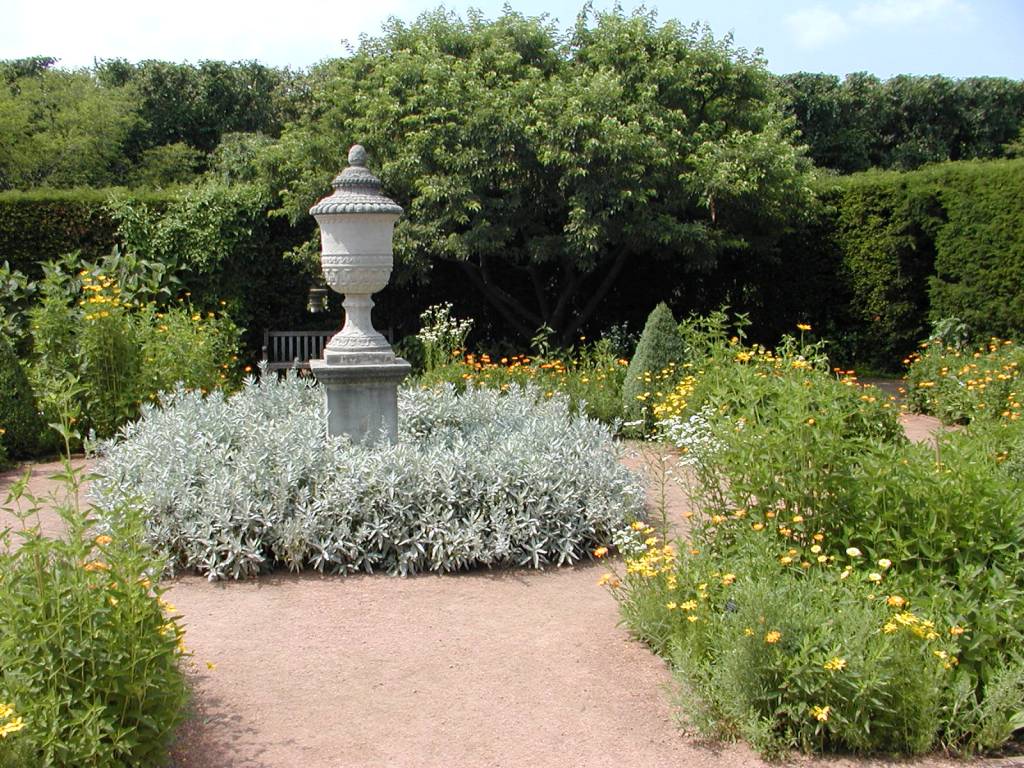
color and texture, including fall color; bark attributes; and flowering and fruiting habits, to obtain the right shrub for your landscape design.
Shrubs can be used as living fences to delineate space and create garden rooms.
Ornamental Characteristics of Shrubs
Many shrubs are planted for their showy floral displays. You can develop a long season
of bloom by planting various types of shrubs. The time any shrub remains in bloom
varies from a few days to a few months; however, the time of year a shrub blooms remains
the same year after year. Use a variety of shrubs that bloom in sequence to develop
a planting with a long blooming period. Most landscapes have lots of flowers in spring,
with few in summer or fall. Prolong the ornamental season through careful shrub selection.
Choose shrubs known to bloom at alternate times of year, or choose plants that provide
other ornamental traits during hot weather and into the fall such as colorful bark,
fall foliage, or fruit.
A number of ornamental shrubs produce attractive fruit following flowering. Some have
black or dark purple fruit that often go unnoticed, unless sited for contrast. Brightly
colored fruit make a better show than dull colors. The time fruit is ornamental should
be a consideration. Fruit persisting into winter provides color in the winter landscape.
A shrub may produce beautiful fruit, but too few to be noticed, so their ornamental
value is low. Within limits, the larger the fruit the more ornamental it may be. Conversely,
large fruit can be a problem to clean up.
For shrubs such as holly and yew, male and female flowers are produced on separate
plants and fruit is only produced on the female plants. A plant with this flowering
and fruiting habit is called dioecious. When female, fruiting plants are desired,
a male plant must also be grown to ensure pollination. Usually one male shrub pollinates
several female plants.
Foliage color, other than green, can occur in fall, in spring, or from spring to fall.
The foliage of shrubs with showy spring color often fades to green or off green by
summer. Colored foliage or variegated shrubs can be less vigorous than the natural
form with green foliage. Shrubs with colored or variegated foliage may need different
light intensity. Sunlight is often necessary for good fall color development or summer
foliage coloration. For example, barberry cultivars with purple leaves in the sun
may have nearly green leaves in the shade.
Bark is another ornamental feature. The bark may be highly colored or have interesting
texture. Shrubs with evergreen foliage, brightly colored bark, or striking bark textures
and patterns can provide winter color and interest.
Attracting wildlife may be a reason for selecting a particular shrub. Some shrubs
produce fruits eaten by birds and others provide shelter; while some yield flowers
that attract butterflies.
Some shrubs have safety concerns that should be considered. Don’t plant shrubs with
poisonous berries near public walkways. Keep in mind that plants with poisonous parts
or spiny foliage or stems should be avoided in high traffic areas. On the other hand,
spiny shrubs/hedges may provide “traffic control” and security for an area.
Select shrubs hardy enough to survive the winter and durable enough to endure the
Oklahoma summer heat.
Avoid shrubs with serious pest problems. The large selection of available shrubs makes
it unnecessary to use those notorious for annual infestations of insects or diseases.
Pests attack most shrubs during their lives, but most can be easily controlled or
ignored. Shrubs to avoid are those with serious pest problems that render the plants
aesthetically unacceptable.
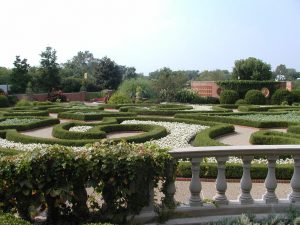
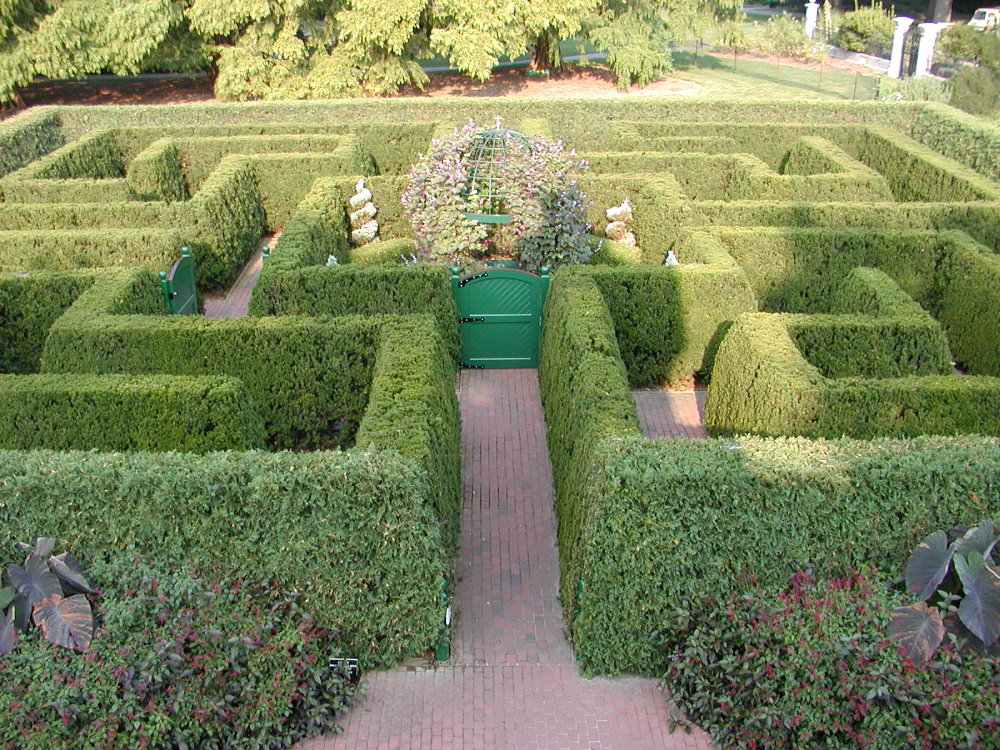
Shrubs pruned in a formal fashion can be used to create
fun and creative garden designs.
Shrubs for a Purpose
Tolerates or Prefers Dry Locations
Most or all of the shrubs listed below will still require vigilant irrigation for
at least the first growing season. However, upon establishment, plants below are known
to tolerate or even prefer dry sites. Tolerance to dry or xeric conditions will widely
differ amongst these species.
- Abelia, Glossy (Abelia x grandiflora)
- Althea or Rose of Sharon, (Hibiscus syriacus)
- Aralia, Fiveleaf (Eleutherococcus sieboldianus)
- Aucuba, Japanese (Aucuba japonica)
- Barberry, Japanese (Berberis thunbergii)
- Barberry, Mentor (Berberis x mentorenesis)
- Beautyberry (Callicarpa americana)
- Bluebeard or Blue-mist shrub (Caryopteris x clandonensis)
- Blueberry, Highbush (Vaccinium corymbosum)
- Bush-Honeysuckle, Southern (Diervilla sessilifolia)
- Chokeberry, Black or Red (Aronia melanocarpa or A. arbutifolia)
- Cinquefoil, Bush (Potentilla fruticosa)
- Coralberry, Indiancurrant, or Buckbrush (Symphoricarpos orbiculatus)
- Coralberry, Chenault (Symphoricarpos x chenaultii)
- Cotoneaster, Rock (Cotoneaster apiculatus)
- Cotoneaster, Spreading (Cotoneaster divaricatus)
- Cotoneaster, Willowleaf (Cotoneaster salicifolius)
- Devil’s-walkingstick (Aralia spinosa)
- Dogwood, Gray (Cornus racemosa)
- Dogwood, Roughleaf (Cornus asperifolia var. drummondii)
- Firethorn (Pyracantha coccinea)
- Holly, Chinese (Ilex cornuta)
- Holly, Yaupon (Ilex vomotoria)
- Honeysuckle, Morrow (Lonicera morrowii)
- Honeysuckle, Tatarian (Lonicera tatarica)
- Honeysuckle, Winter (Lonicera fragrantissima)
- Hydrangea, smooth (Hydrangea arborescens)
- Indian Hawthorn (Rhaphiolepis spp.)
- Juniper (Juniperus spp.)
- Nandina or Heavenly Bamboo (Nandina domestica)
- Ninebark, (Physocarpus opulifolius)
- Paradise Ponciana or Bird of Paradise (Caesalpinia gilliesi)
- Pearl Bush (Exochorda racemosa)
- Photinia (Photinia spp.)
- Plum, American (Prunus americana)
- Plum, Sandhill (Prunus angustifolia)
- Privet (Ligustrum spp.)
- Quince, flowering (Chaenomeles speciosa)
- Rose, rugosa (Rosa rugosa)
- Saint Johnswort (Hypericum spp.)
- Serviceberry, Shadblow (Amelanchier canadensis)
- Siberian Peashrub (Caragana arborescens)
- Spirea, Anthony Waterer (Spiraea x bumalda ‘Anthony Waterer’)
- Spirea, Vanhoutte (Spiraea x vanhouttei)
- Sumac, Fragrant (Rhus aromatica)
- Sumac, Smooth (Rhus glabra)
- Witchhazel (Hamamelis spp.)
- Yucca (Yucca spp.)
Tolerates or Prefers Wet Locations
Plants listed below will only tolerate flooding for short periods of time (normally
only a few days). Very few will actually survive long-term submersion of their root
systems.
- Beautyberry, Purple (Callicarpa dichotoma)
- Buttonbush (Cephalanthus occidentalis)
- Chokeberry (Aronia spp.)
- Cinquefoil, Bush (Potentilla fruticosa)
- Devilwood, False holly or Osmanthus (Osmanthus heterophyllus)
- Dogwood, Redosier (Cornus sericea)
- Dogwood, Roughleaf (Cornus asperifolia)
- Dogwood, Silky (Cornus amomum)
- Elder, American or Elderberry (Sambucus canadensis)
- Holly, Deciduous or Possumhaw (Ilex decidua)
- Holly, Inkberry (Ilex glabra)
- Summersweet (Clethra alnifolia)
- Sweetshrub, California (Calycanthus occidentalis)
- Sweetspire, Virginia (Itea virginica)
- Viburnum, European or Snowball (Viburnum opulus)
- Waxmyrtle, Southern (Morella cerifera)
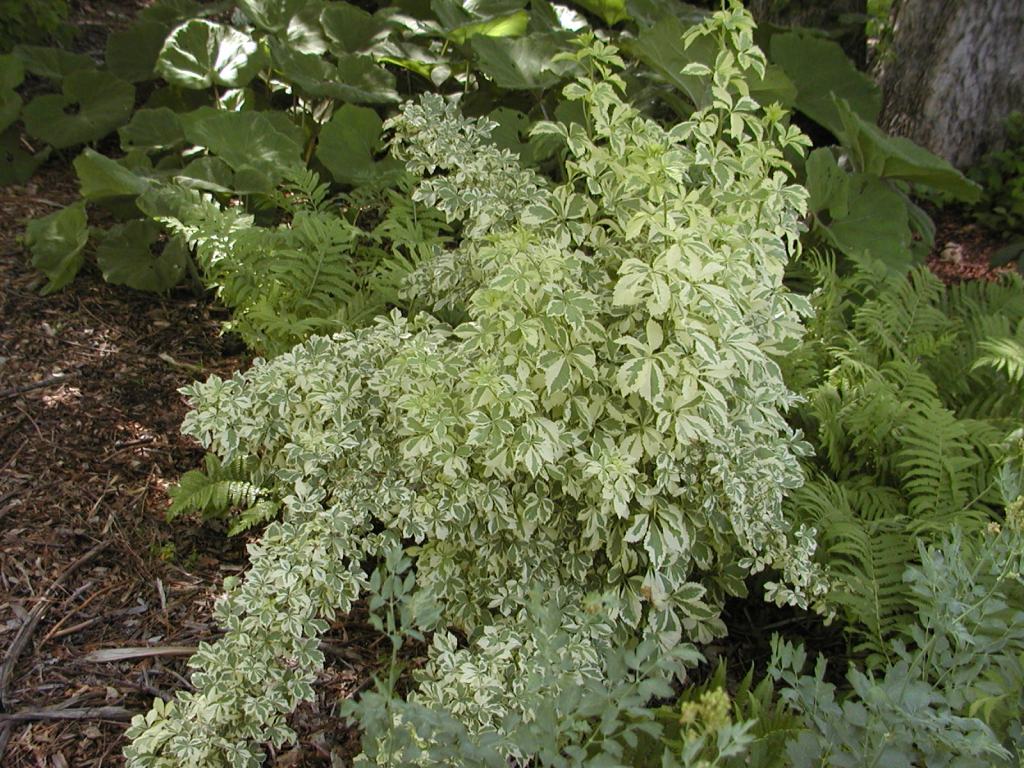
Shrubs with variegated foliage, like this five-leaf aralia, really stand out in shady areas
Tolerates or Prefers Shade
The following plants will perform well under shady conditions.
- Abelia, Glossy (Abelia x grandiflora)
- Aralia, Fiveleaf (Eleutherococcus sieboldianus)
- Aucuba, Japanese (Aucuba japonica)
- Azalea (Rhododendron spp.)
- Barberry, Japanese (Berberis thunbergii)
- Barberry, Mentor (Berberis x mentorenesis)
- Boxwood, Common (Buxus sempervirens)
- Buttonbush (Cephalanthus occidentalis)
- Camellia (Camellia spp.)
- Coralberry or Snowberry (Symphoricarpos spp.)
- Currant, Golden (Ribes aplinum ‘Aureum’)
- Dogwood, Redosier (Cornus sericea)
- Euonymus (Euonymus spp.)
- Fothergilla (Fothergilla spp.)
- Holly (Ilex spp.)
- Honeysuckle, Winter (Lonicera fragrantissima)
- Hydrangea (Hydrangea spp.)
- Jasmine, Winter (Jasminum nudiflorum)
- Jetbead, Black (Rhodotypos scandens)
- Kerria, Japanese (Kerria japonica)
- Mockorange (Philadelphus spp.)
- Mahonia, creeping (Mahonia repens)
- Mahonia, Leatherleaf (Mahonia bealei)
- Nandina, Heavenly bamboo (Nandina domestica)
- Pine, Mugo (Pinus mugo var. mugo)
- Privet (Ligustrum spp.)
- Spirea, Vanhoutte (Spiraea x vanhouttei)
- Sweetspire, Virginia (Itea virginica)
- Weigela, Old fashioned (Weigela florida)
- Yew, (Taxus spp.)
- Viburnum (Viburnum spp.)
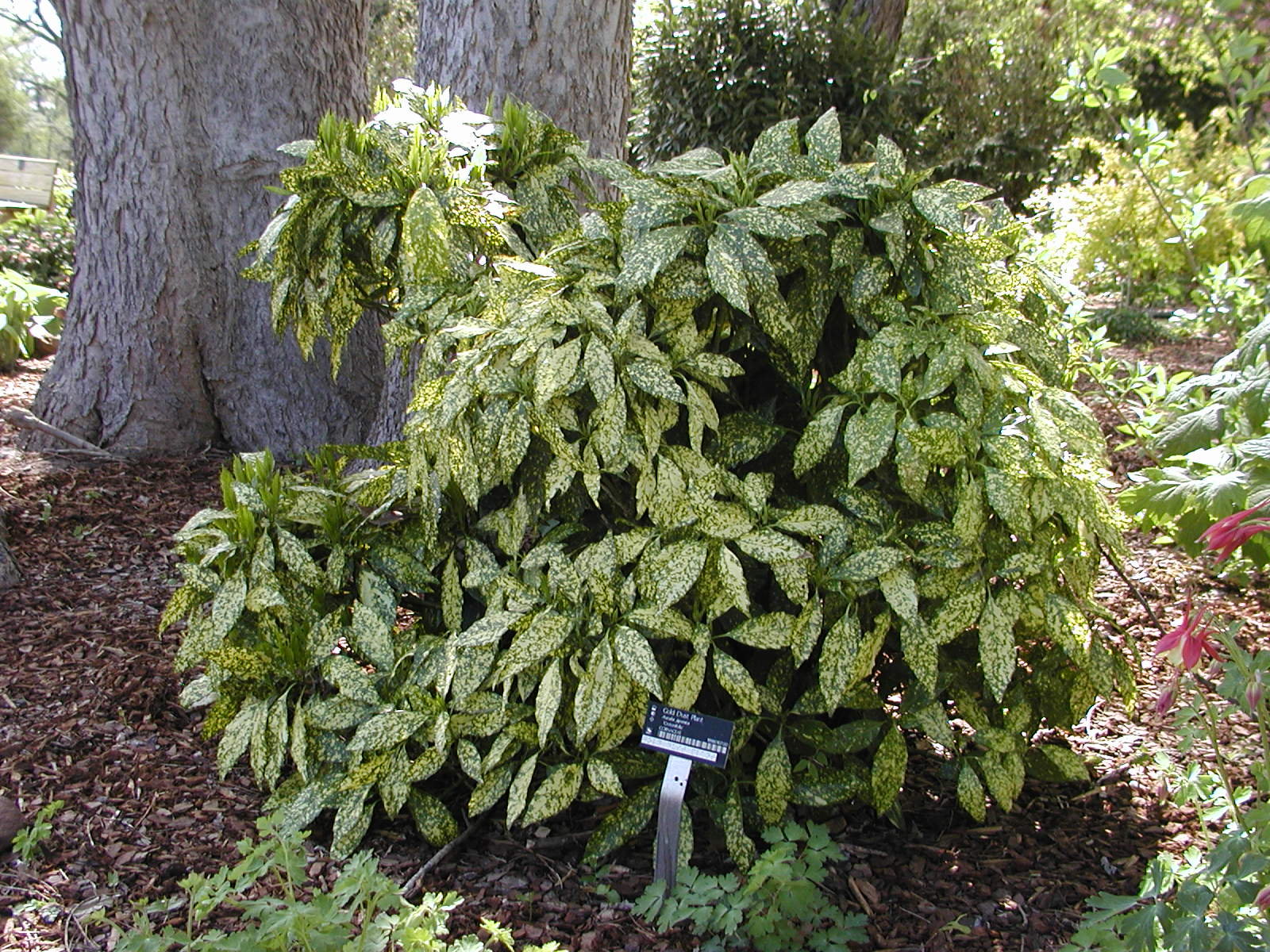
Aucuba or Gold Dust plant is excellent for heavily shaded areas.
Shrubs with variegated leaves
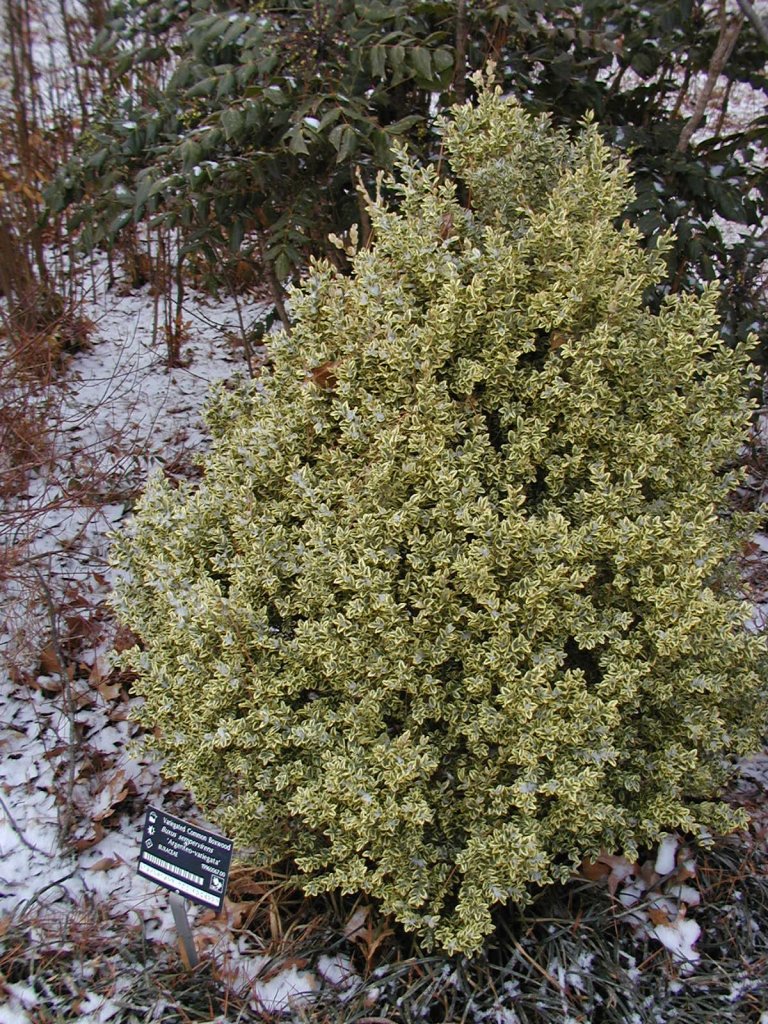
Common Boxwood
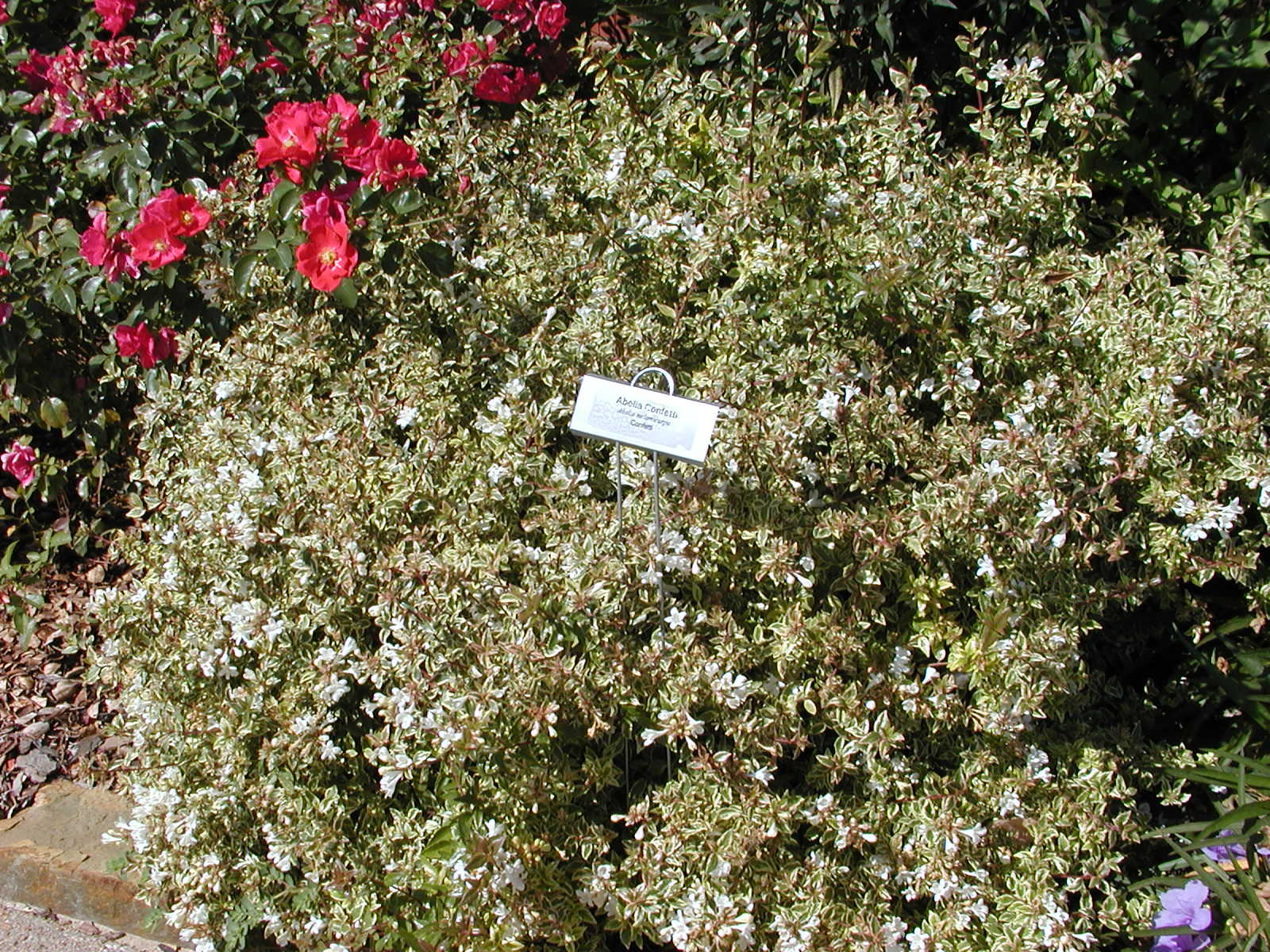
Abelia ‘Confetti’
Tolerates or Prefers Alkaline Soils
Many of the plants listed below will thrive and remain green despite growing in high
pH soils. However, when pH values exceed pH 8.0 or higher, it may be difficult to
grow some of the species below.
- Althea or Rose of Sharon (Hibiscus syriacus)
- Barberry (Berberis spp.)
- Beautyberry, Purple (Callicarpa dichotoma)
- Beautybush (Kolkwitzia amabilis)
- Bluebeard or Blue-mist Shrub (Caryopteris x clandonensis)
- Boxwood (Buxus spp.)
- Buddleia or Butterfly Bush (Buddleia davidii)
- Bush cinquefoil (Potentilla fruticosa)
- Carolina Allspice or Sweetshrub (Calycanthus floridus)
- Chokeberry (Aronia spp.)
- Cotoneaster (Cotoneaster spp.)
- Crapemyrtle (Lagerstroemia indica)
- Dogwood, Redosier or Red Twig (Cornus sericea)
- Euonymus (Euonymus spp.)
- Firethorn (Pyracantha spp.)
- Forsythia (Forsythia x intermedia)
- Honeysuckle (Lonicera spp.)
- Juniper (Juniperus spp.)
- Lilac (Syringa spp.)
- Mahonia (Mahonia spp.)
- Mockorange (Philadelphus spp.)
- Nandina (Nandina domestica)
- Ninebark (Physocarpus spp.)
- Pine (Pinus spp.)
- Privet (Ligustrum spp.)
- Snowberry (Symphoricarpos albus)
- Spirea (Spiraea spp.)
- Viburnum (Viburnum spp.)
- Yew (Taxus spp.)
- Yucca (Yucca spp.)
Tolerates Salty Soils
Plants below have varying degrees of tolerance to saline soils. While some may survive
salty soils, the homeowner should still expect the possibility of burned or scorched
leaves with overall stunting of the plant a possibility.
- Bayberry, northern (Myrica pensylvanica)
- Blueberry, highbush (Vaccinium corymbosum)
- Bush-Honeysuckle, southern (Diervilla sessilifolia)
- Chokeberry, black (Aronia melanocarpa)
- Chokeberry, red (Aronia arbutifolia)
- Cinquefoil, bush (Potentilla fruticosa)
- Cotoneaster, rock (Cotoneaster apiculatus)
- Cotoneaster, spreading (Cotoneaster divaricatus)
- Cotoneaster, willowleaf (Cotoneaster salicifolius)
- Holly, inkberry (Ilex glabra)
- Holly, Japanese (Ilex crenata)
- Hydrangea, bigleaf (Hydrangea macrophylla)
- Hydrangea, oakleaf (Hydrangea quercifolia)
- Hydrangea, panicle (Hydrangea paniculata)
- Hydrangea, smooth (Hydrangea arborescens)
- Juniper, shore (Juniperus conferta)
- Lilac, littleleaf (Syringa microphylla)
- Lilac, Manchurian (Syringa patula ‘Miss Kim’)
- Lilac, Meyer (Syringa meyeri ‘Palibin’)
- Privet, Amur (Ligustrum amurense)
- Rose, rugosa (Rosa rugosa)
- Viburnum, Arrowwood (Viburnum dentatum)
- Viburnum, blackhaw (Viburnum prunifolium)
- Viburnum, siebold (Viburnum sieboldii)
- Yew, Anglojap (Taxus x media cultivars)
- Yew, Japanese (Taxus cuspidata)
Winter Interest
Many plants have ornamental merit during the cold months. There are a number of other attributes to seek out in addition to flowers; many plants have characteristics that set them above other plants, such as the colorful bark of redosier dogwood, the colorful fruit of deciduous holly that persist into the winter, and the unusual branching habit of Harry Lauder’s walkingstick.
Showy Bark/Branches or Unusual Form:
- Beautybush (Kolkwitzia amabilis)
- Dogwood, redosier (Cornus sericea)
- Dogwood, yellowtwig (Cornus sericea ‘Flaviramea’)
- Euonymus, Winged or Burning bush (Euonymus alatus)
- Harry Lauder’s walkingstick (Corylus avellana ‘Contorta’)
- Honeysuckle (Lonicera spp.)
- Kerria, Japanese (Kerria japonica)
Interesting Stems or Bark
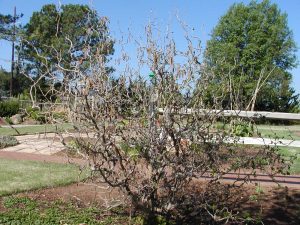
Harry Lauder’s Walkingstick
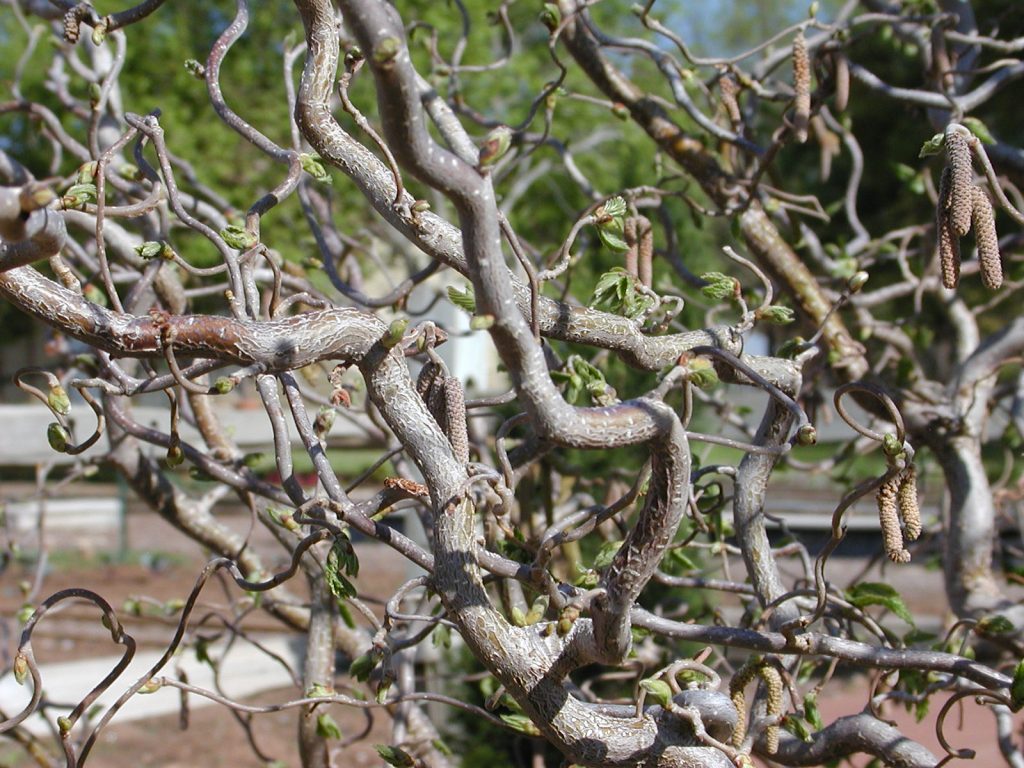
Harry Lauder’s Walkingstick
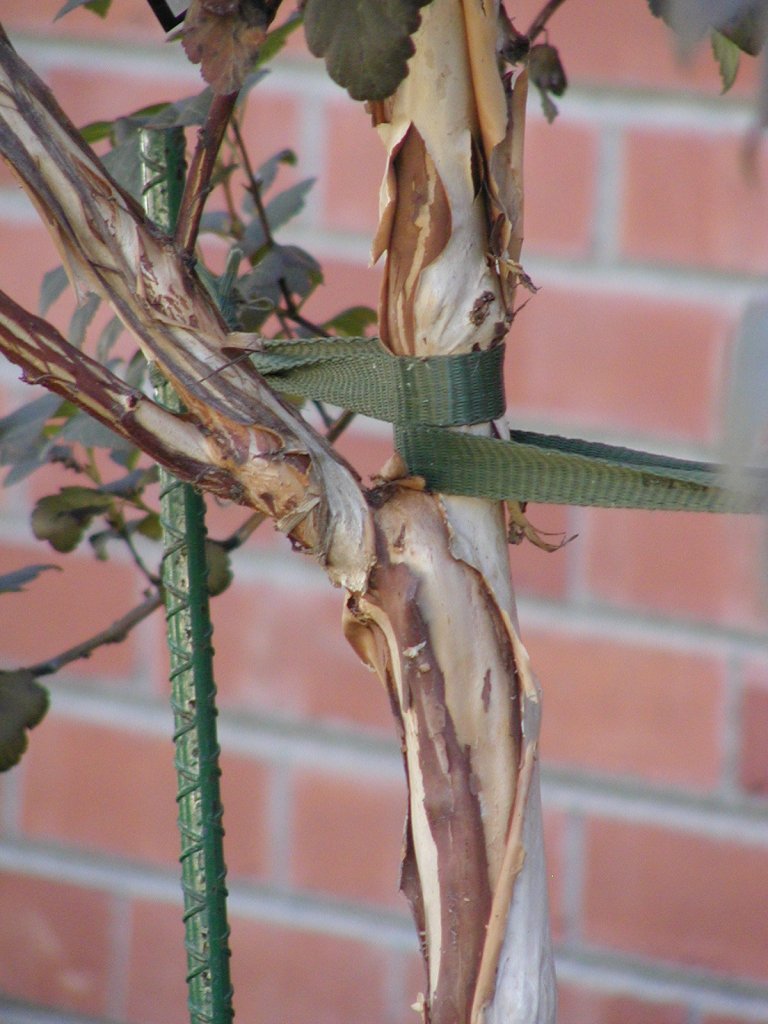
Diablo Ninebark
Interesting or Showy Fruit:
- Barberry, Japanese (Berberis thunbergii)
- Beautyberry (Callicarpa japonica)
- Buckthorn, Carolina (Rhamnus caroliniana)
- Buffaloberry, Silver (Shepherdia argentea)
- Buttonbush (Cephalanthus occidentalis)
- Chokeberry, Black (Aronia melanocarpa)
- Chokeberry, Red (Aronia arbutifolia)
- Coralberry, Indiancurrant or Buckbrush (Symphoricarpos orbiculatus)
- Cotoneaster (Cotoneaster spp.)
- Dogwood (Cornus spp.)
- Elder or Elderberry (Sambucus spp.)
- Euonymus (Euonymus spp.)
- Firethorn (Pyracantha coccinea)
- Hardy orange (Poncirus trifoliata)
- Holly (Ilex spp. and hybrids)
- Honeysuckle, Morrow (Lonicera morrowii)
- Honeysuckle, Tatarian (Lonicera tatarica)
- Jetbead, Black (Rhodotypos scandens)
- Juniper (Juniperus spp.)
- Mahonia (Mahonia spp.)
- Nandina or Heavenly bamboo (Nandina domestica)
- Privet (Ligustrum spp.)
- Sumac (Rhus spp.)
- Viburnum (Viburnum spp.)
Flowers During Winter and Early Spring
- Camellia (Camellia spp.)
- Forsythia (Forsythia spp.)
- Jasmine, winter (Jasminum nudiflorum)
- Honeysuckle, winter (Lonicera fragrantissima)
- Quince, Flowering (Chaenomeles spp.)
- Spirea (certain Spiraea spp.)
- Witchhazel (Hamamelis spp.)
- Winterhazel (Corylopsis spp.)
Showy Flowers
We expect herbaceous annual and perennial ornamental plants to bloom in the landscape,
but it is an added bonus when shrubs bloom. The following shrubs provide colorful,
showy flowers.
- Abelia, glossy (Abelia x grandiflora)
- Althea or Rose of Sharon (Hibiscus syriacus)
- Azalea (Rhododendron spp.)
- Barberry (Berberis spp.)
- Beautyberry (Callicarpa japonica)
- Beautybush (Kolkwitzia amabilis)
- Bluebeard or Blue-mist Shrub (Caryopteris x clandonensis)
- Bush Cinqefoil (Potentilla fruticosa)
- Buttonbush (Cephalanthus occidentalis)
- Butterfly bush (Buddleia spp.)
- Camellia (Camellia spp.)
- Carolina Allspice or Sweetshrub (Calycanthus floridus)
- Cherrylaurel, Carolina (Prunus caroliniana)
- Cherrylaurel, Otto Luyken (Prunus laurocerasus ‘Otto Luyken’)
- Cherrylaurel, Common (Prunus laurocerasus)
- Cotoneaster (Cotoneaster spp.)
- Crapemyrtle (Lagerstroemia indica)
- Flowering quince (Chaenomeles speciosa)
- Forsythia (Forsythia spp.)
- Honeysuckle (Lonicera spp.)
- Hydrangea (Hydrangea spp.)
- Indian Hawthorn (Rhaphiolepis spp.)
- Lilac (Syringa spp.)
- Mahonia (Mahonia spp.)
- Mockorange, sweet (Philadelphus spp.)
- Nandina or Heavenly bamboo (Nandina domestica)
- Pearl Bush (Exochorda spp.)
- Photinia (Photinia spp.)
- Pyracantha or Firethorn (Pyracantha coccinea)
- Rose (Rosa spp.)
- Sand plum (Prunus angustifolia)
- Siberian peashrub (Caragana arborescens)
- Spirea (Spiraea spp.)
- St. Johnswort (Hypericum spp.)
- Sweetspire (Itea virginica)
- Viburnums (Viburnum spp.)
- Vitex, Chaste tree (Vitex agnus-castus)
- Weigela (Weigela florida)
- Winter jasmine (Jasminum nudiflorum)
- Witchhazel (Hamamelis vernalis)
Flowering Shrubs
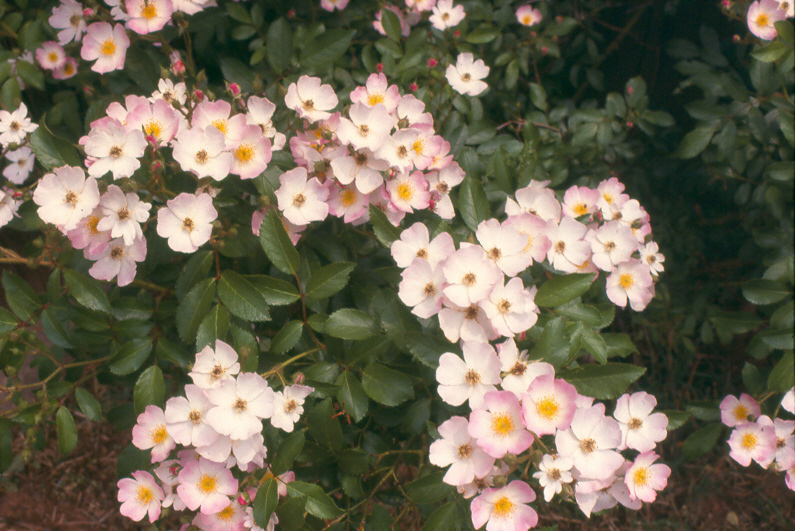
Ballerina Rose

Woadwaxen
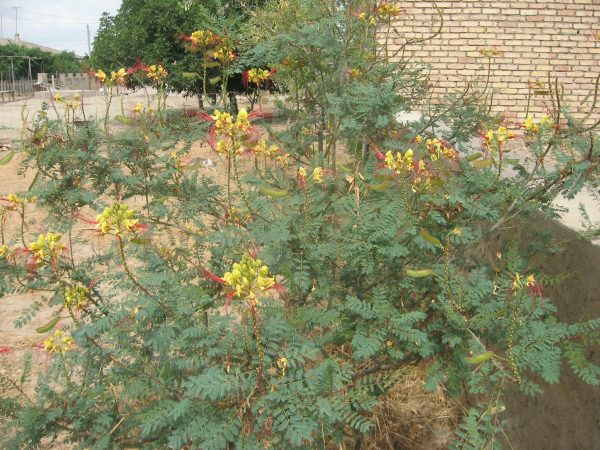
Bird of Paradise
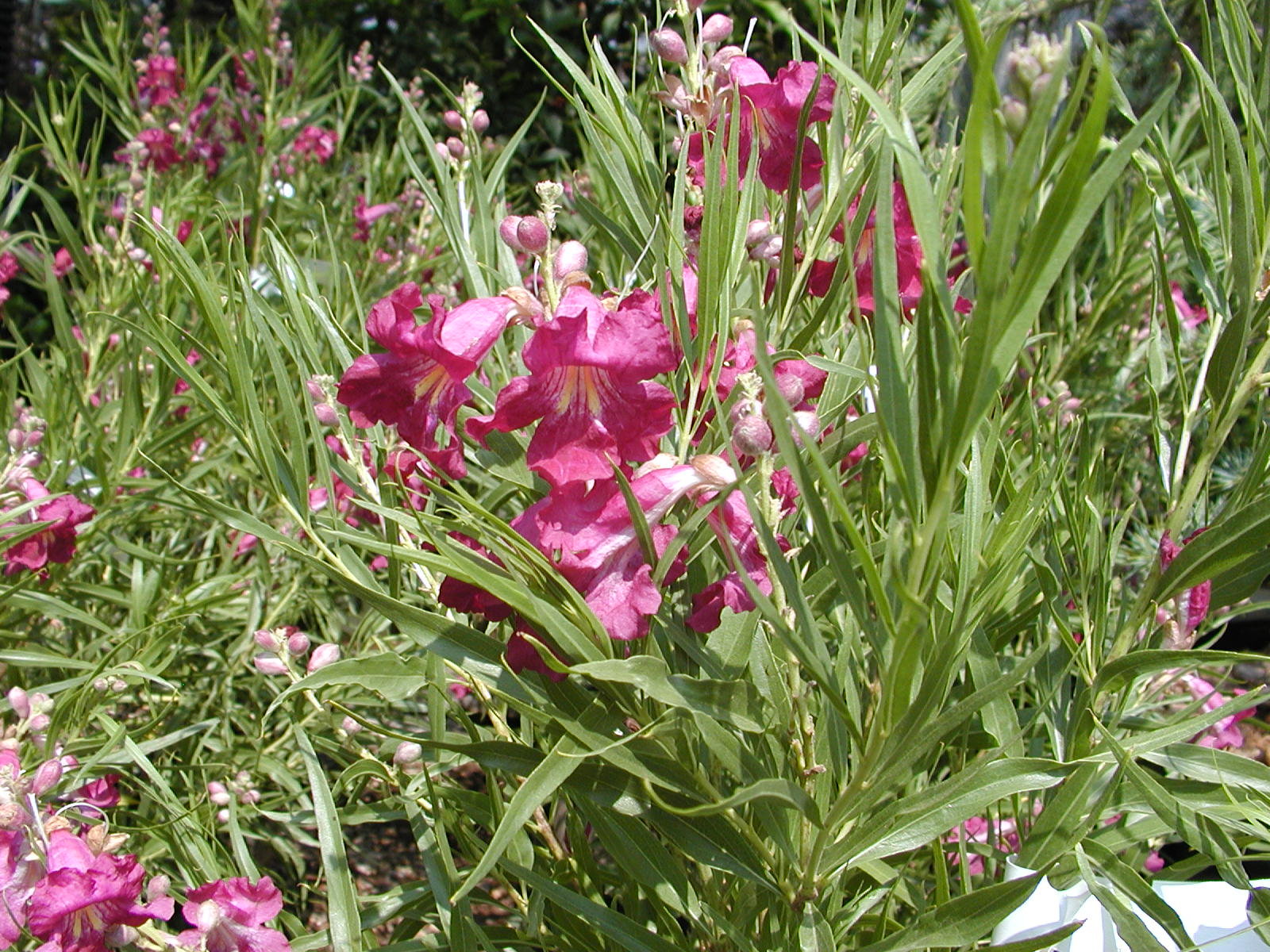
Burgundy Chilopsis

Summersweet

Purple Smoketree
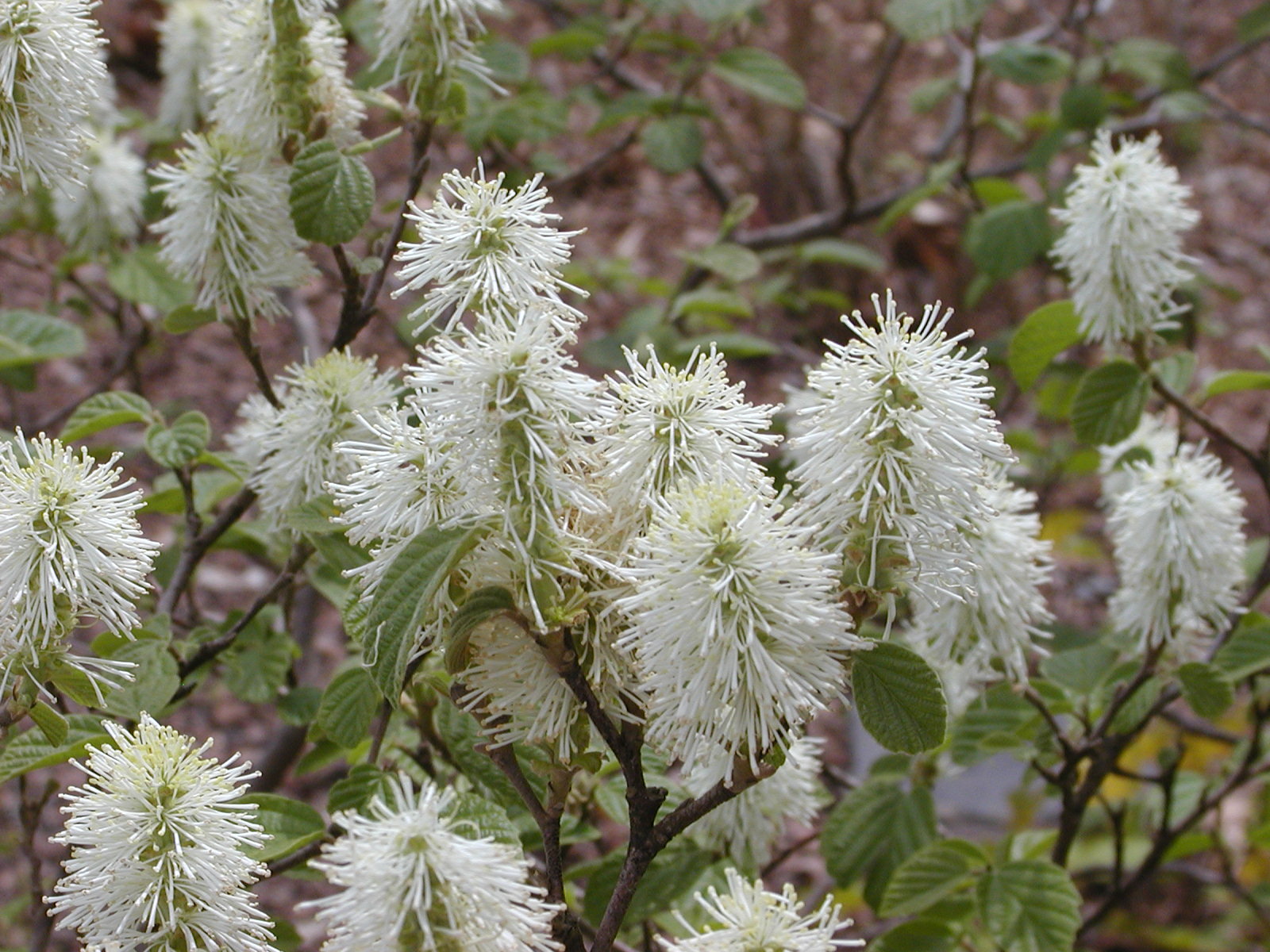
Fothergilla

St. Johnswort

Japanese Kerria
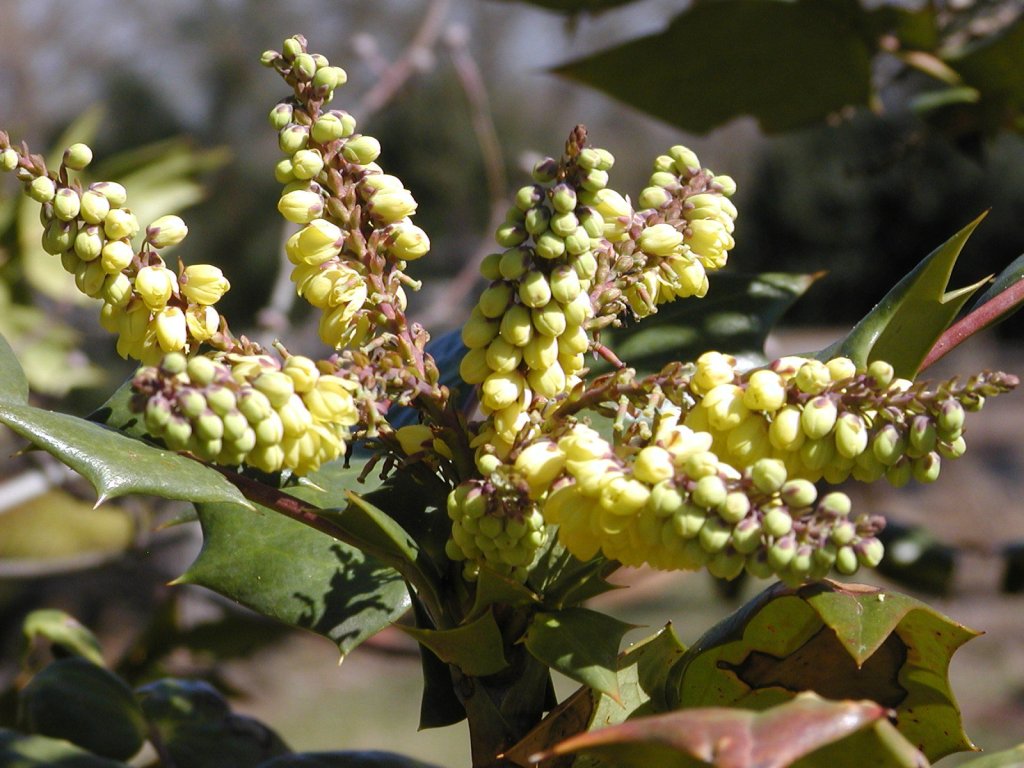
Leatherleaf Mahonia
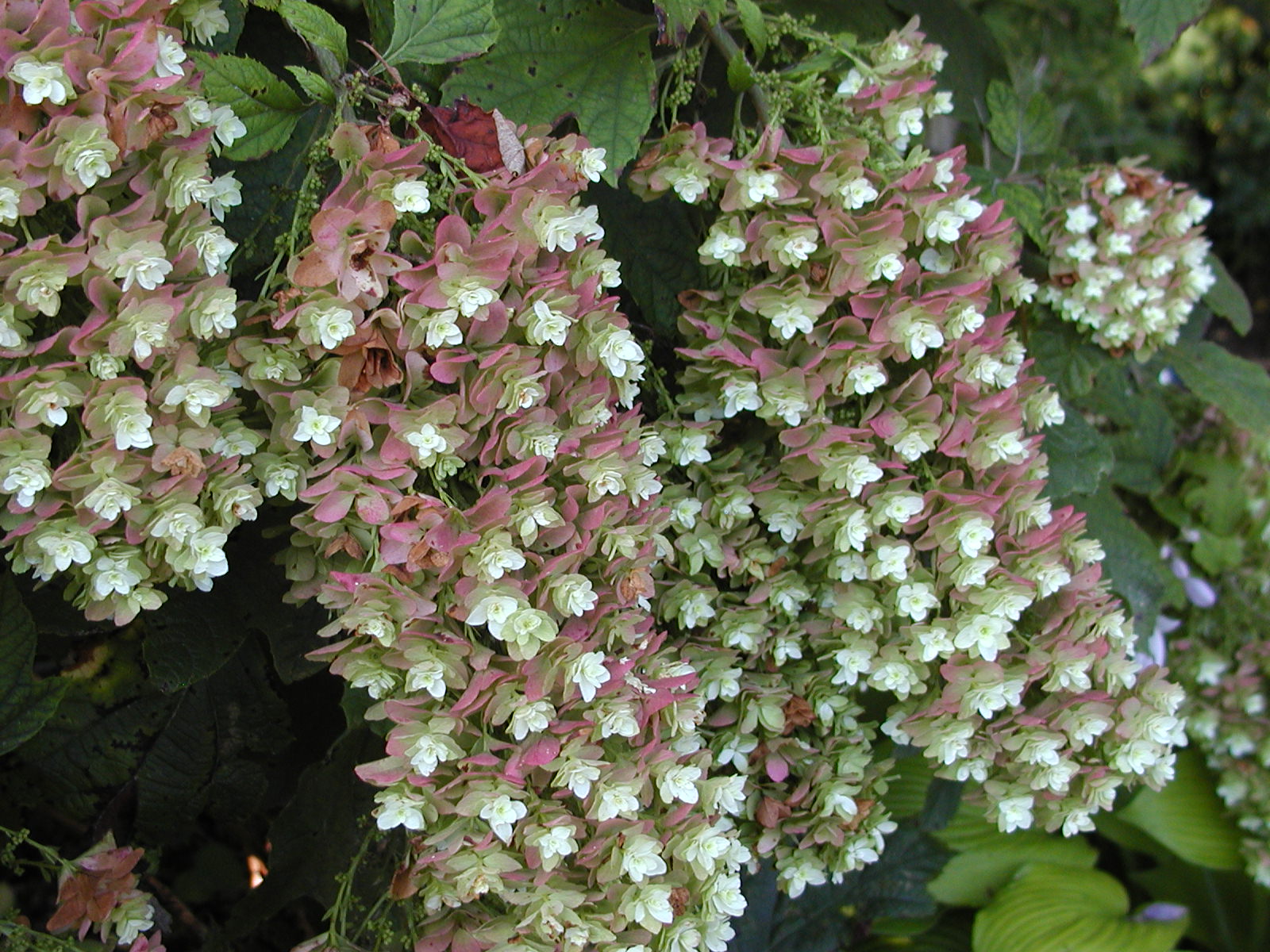
Oakleaf Hydrangea

Azaleas and Japanese Kerria
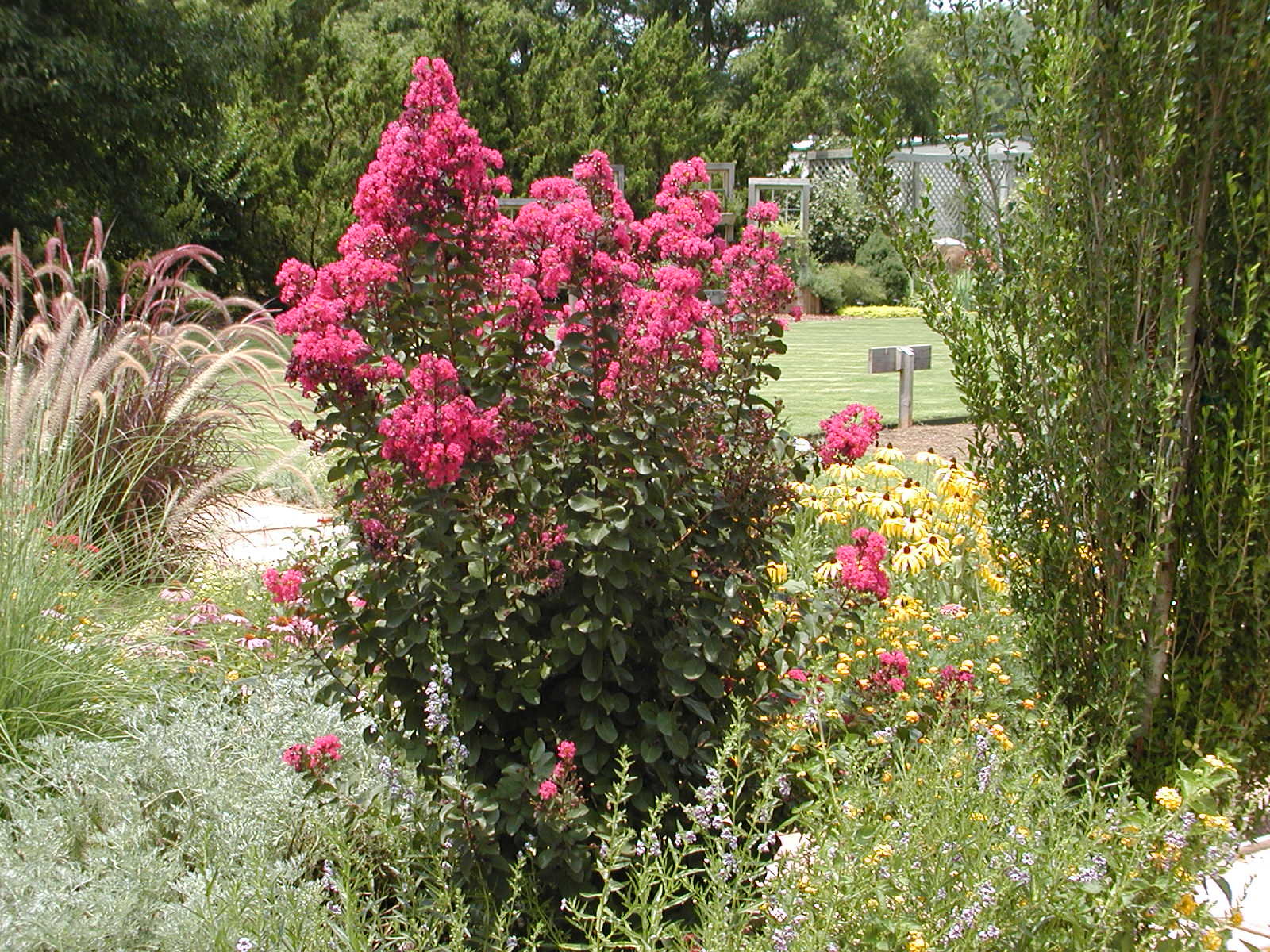
Pink Velour Crapemyrtle

Chastetree
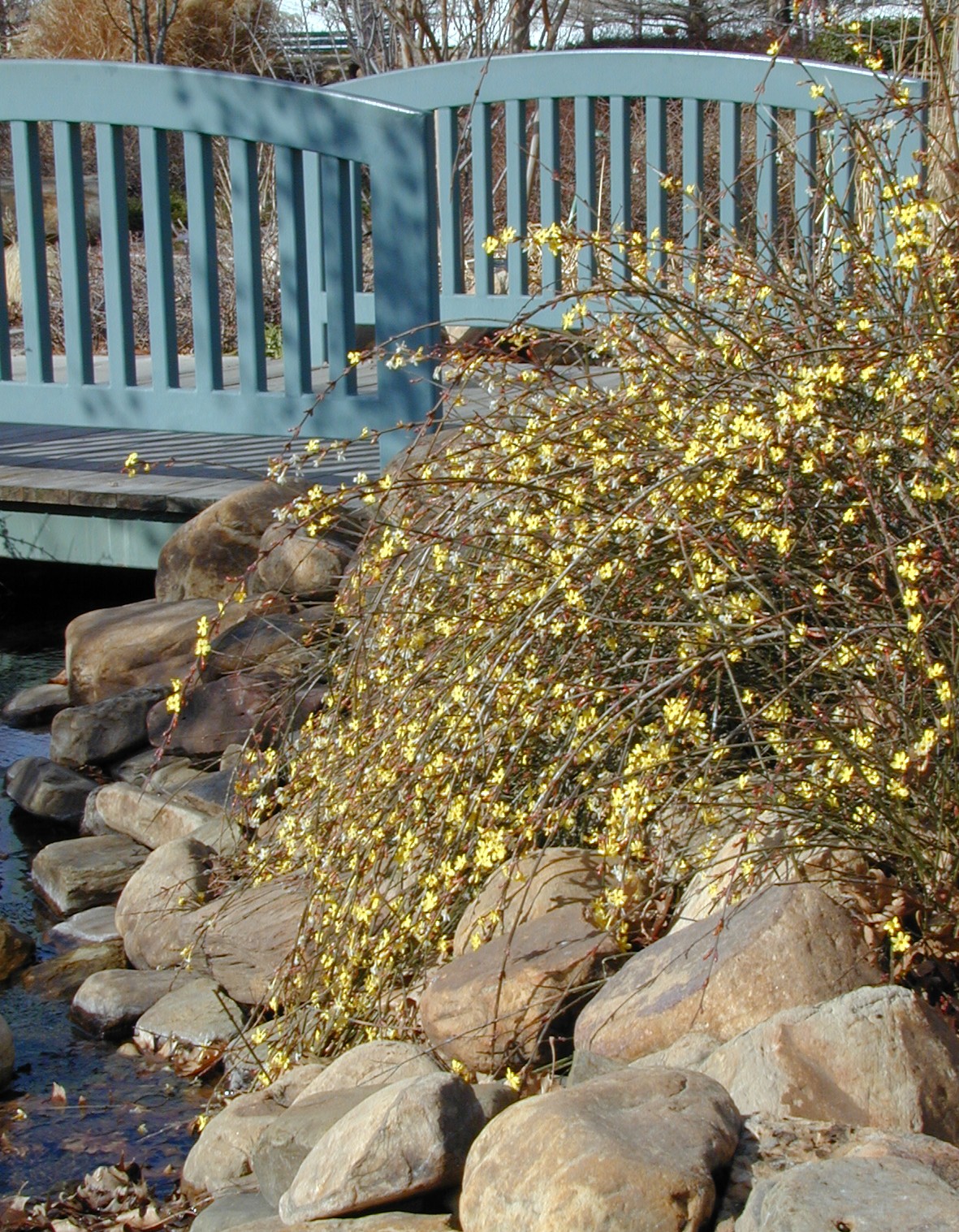
Winter Jasmine
Fall Color
Many factors influence the quality and intensity of fall color for any given year.
Some of the plants listed below have specific species or cultivars that are known
for reliable and markedly vivid fall color. When fall color is the priority trait
desired, it is advisable to purchase the plant in the fall when such colors can be
viewed and critiqued by the consumer.
- Barberry, Japanese (Berberis thunbergii)
- Beautyberry (Callicarpa spp.)
- Blueberry (Vaccinium spp.)
- Carolina Allspice or Sweetshrub (Calycanthus floridus)
- Chokeberry (Aronia spp.)
- Cotoneaster (Cotoneaster spp.)
- Crapemyrtle (Lagerstroemia spp.)
- Dogwood (Cornus spp.)
- Euonymus, Winged or Burning Bush (Euonymus alata)
- Forsythia (Forsythia spp.)
- Fothergilla (Fothergilla spp.)
- Hydrangea, Oakleaf (Hydrangea quercifolia)
- Mahonia, creeping and Oregon grapeholly (Mahonia repens and M. aquifolium)
- Nandina, heavenly bamboo (Nandina domestica)
- Ninebark (Physocarpus spp.)
- Parrotia, Persian (Parrotia persica)
- Serviceberry (Amelanchier spp.)
- Smoketree (Cotinus coggygria)
- Spirea (Spiraea spp.)
- Sumac (Rhus spp.)
- Sweetspire, Virginia (Itea virginica)
- Viburnum (Viburnum spp.)
- Witchhazel (Hamamelis spp.)
Shrubs with colorful foliage
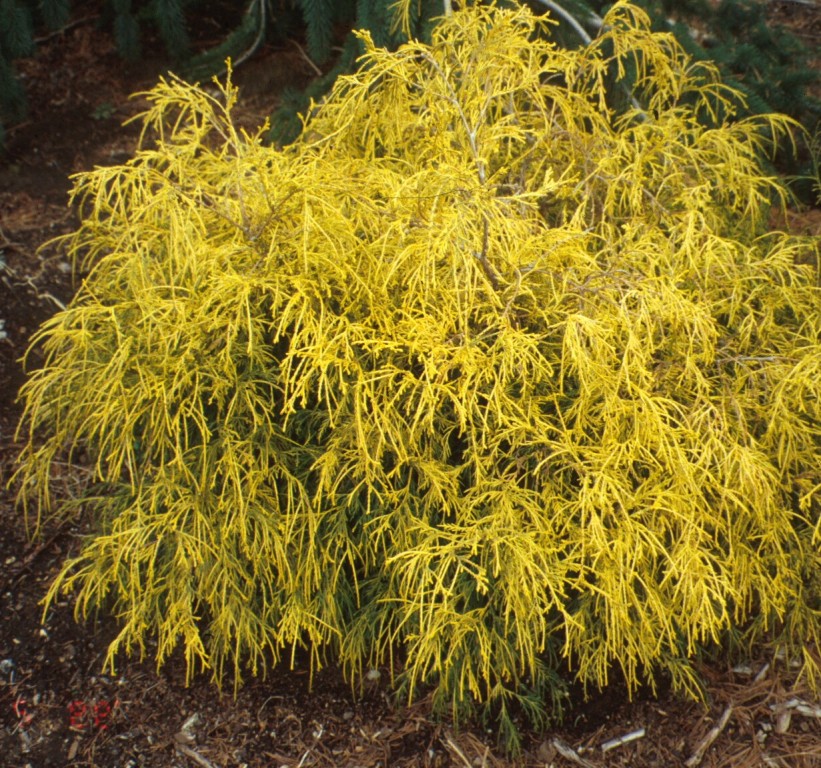
Golden Chamaecyparis
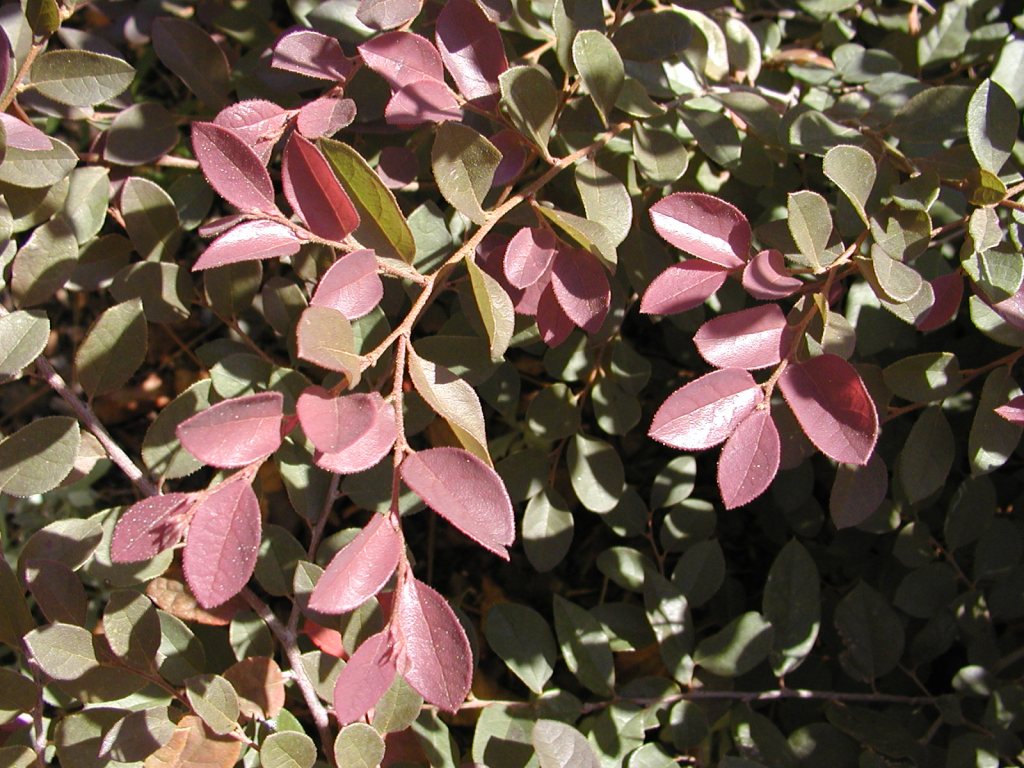
Loropetalum
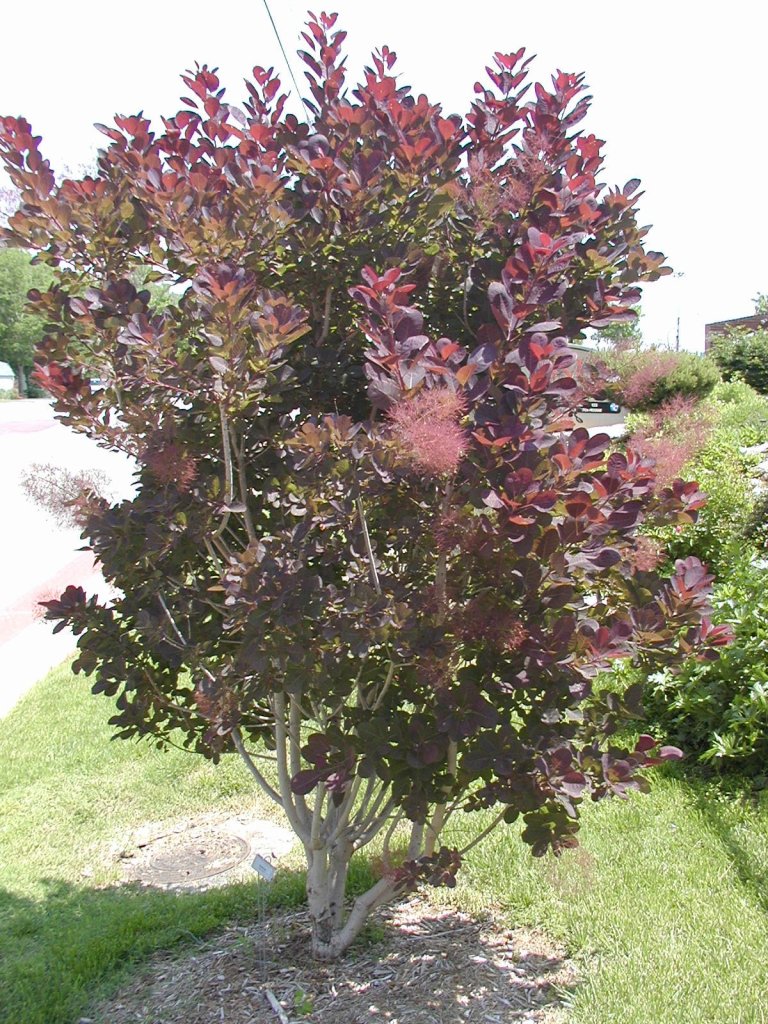
Purple smoketree
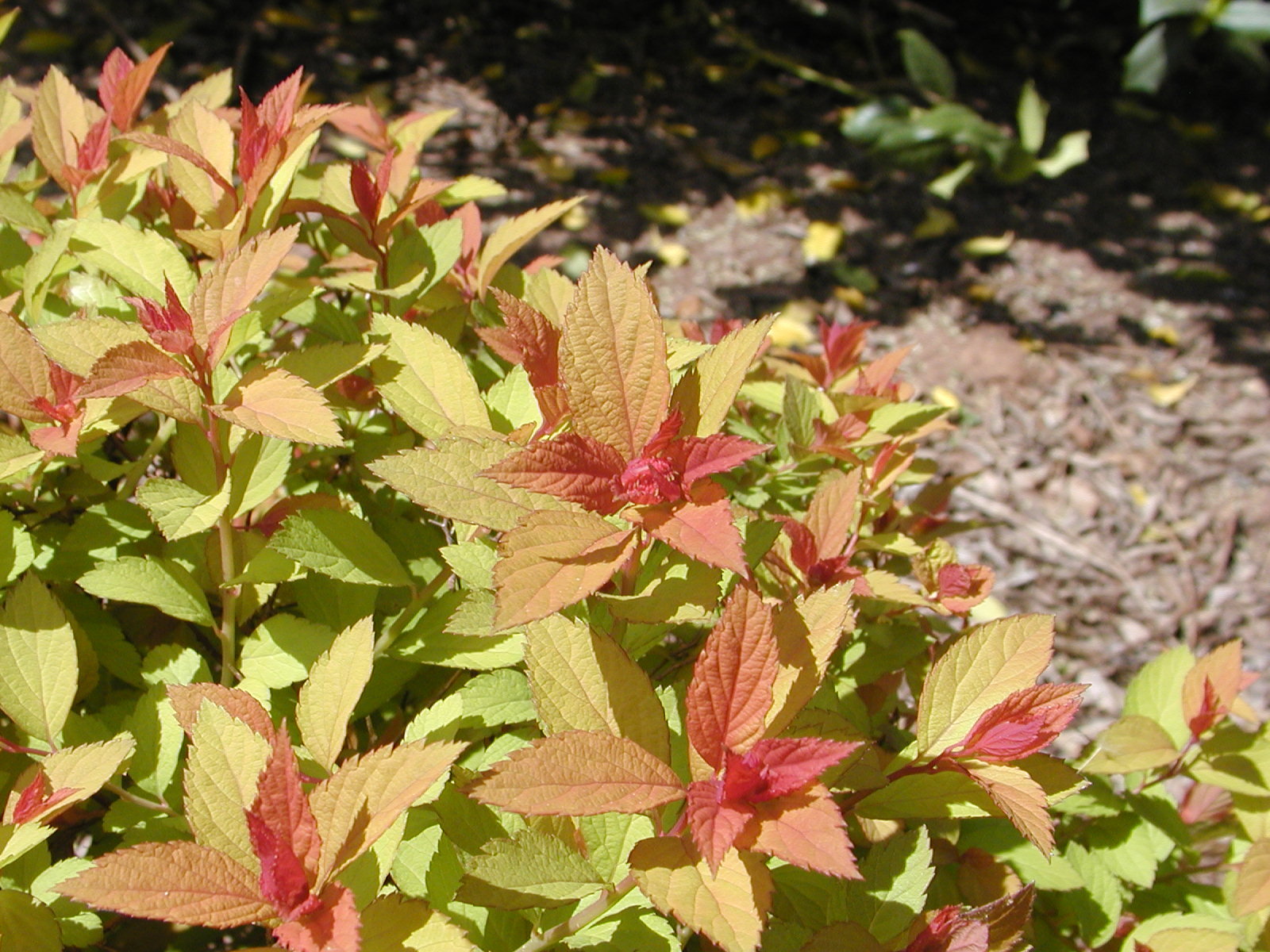
‘Magic Carpet’ Spirea
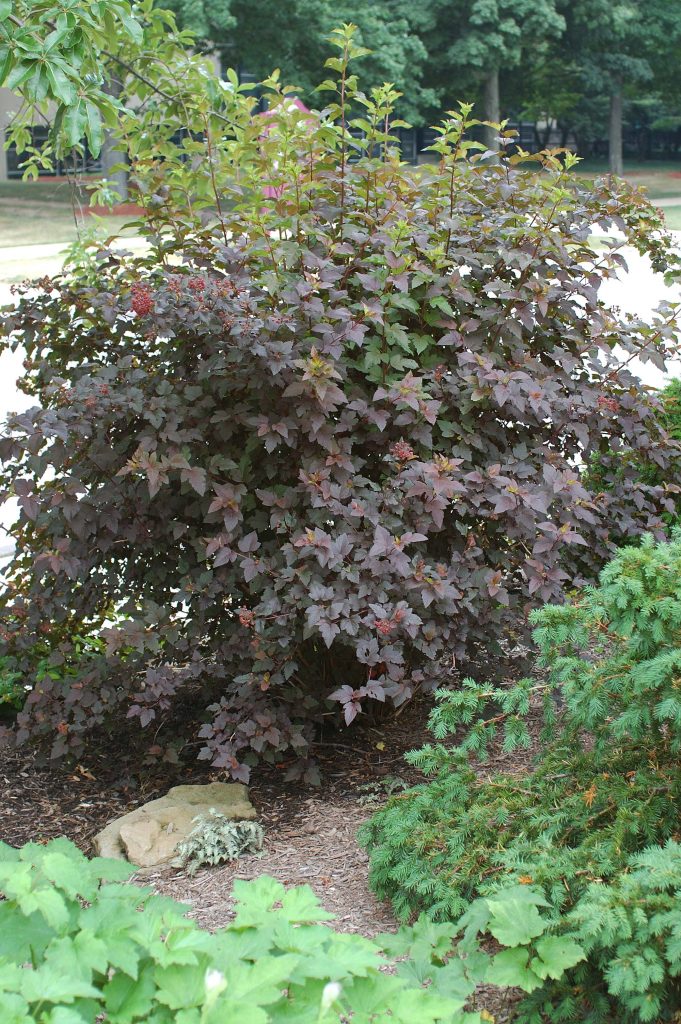
‘Diablo’ Ninebark
Garden and Patio or Large Containers
Just a few of the many plants that are candidates for containers are listed below;
theoretically, most shrubs could be containerized. However, some plants do not perform
well or outgrow containers after many years. If permanent plantings are your expectation,
check with garden center personnel for the best plant or plants to use for long-term
success.
- Abelia, glossy (Abelia x grandiflora)
- Barberry (Berberis spp.)
- Boxwood (Buxus spp.)
- Holly, Evergreen and deciduous (Ilex spp.)
- Juniper (Juniperus spp.)
- Mahonia, creeping (Mahonia repens)
- Nandina, dwarf selections (Nandina domestica)
- Yew (Taxus spp.)
Small Shrubs for Small Spaces
Many species have cultivars that have been selected for their short height or narrow
width at maturity.
- Arborvitae, Dwarf (Thuja spp.)
- Crapemyrtle, Miniature (Lagerstroemia spp.)
- Dwarf Alberta Spruce (Picea glauca ‘Conica’)
- Euonymus, Dwarf Box leaf (Euonymus japonicus ‘Microphyllus’)
- Indian Hawthorn, Ballerina (Rhaphiolepis spp.)
- Junipers (Juniperus spp.)
- Mahonia, Creeping (Mahonia repens)
- Nandina, Dwarf (Nandina domestica)
- Pine, Mugo (Dwarf cultivars) (Pinus mugo)
- Pomegranate, Dwarf (Punica granatum)
- Roses, Miniature (Rosa spp.)
- Waxmyrtle, Dwarf (Myrica spp.)
Shrubs with attractive fruit
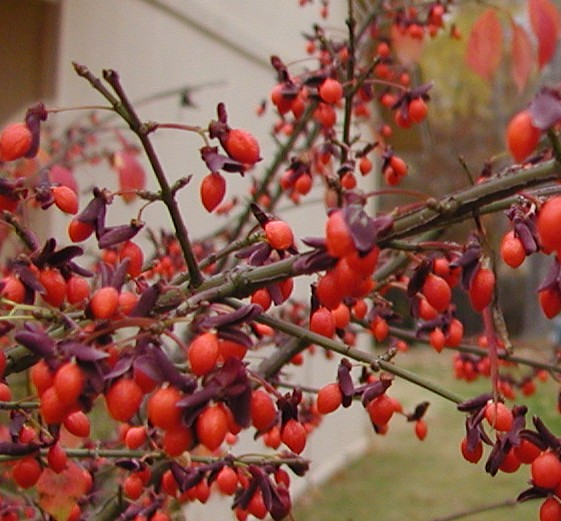
Burning Bush
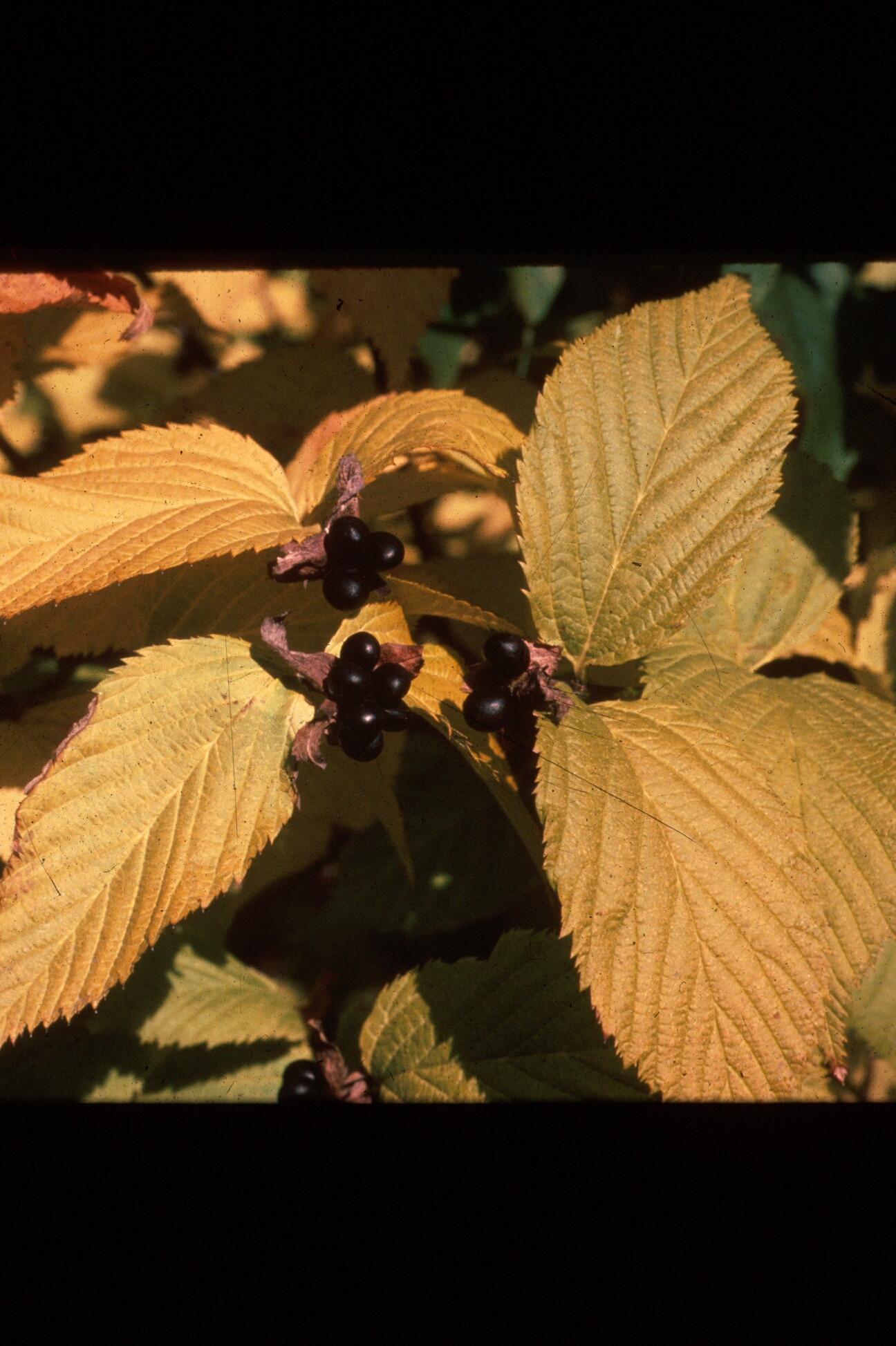
Black Jetbead
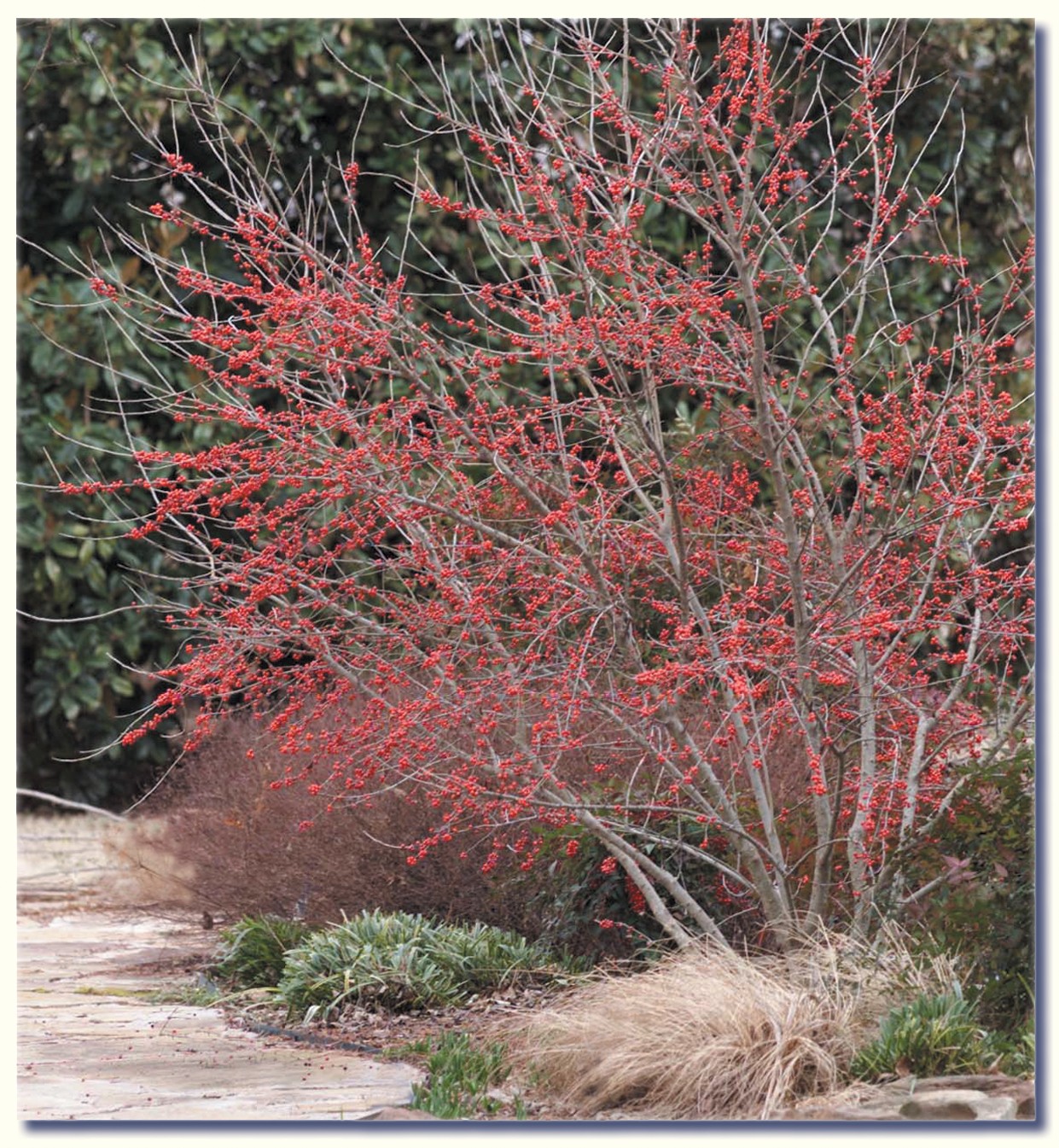
Deciduous Holly

Firethorn
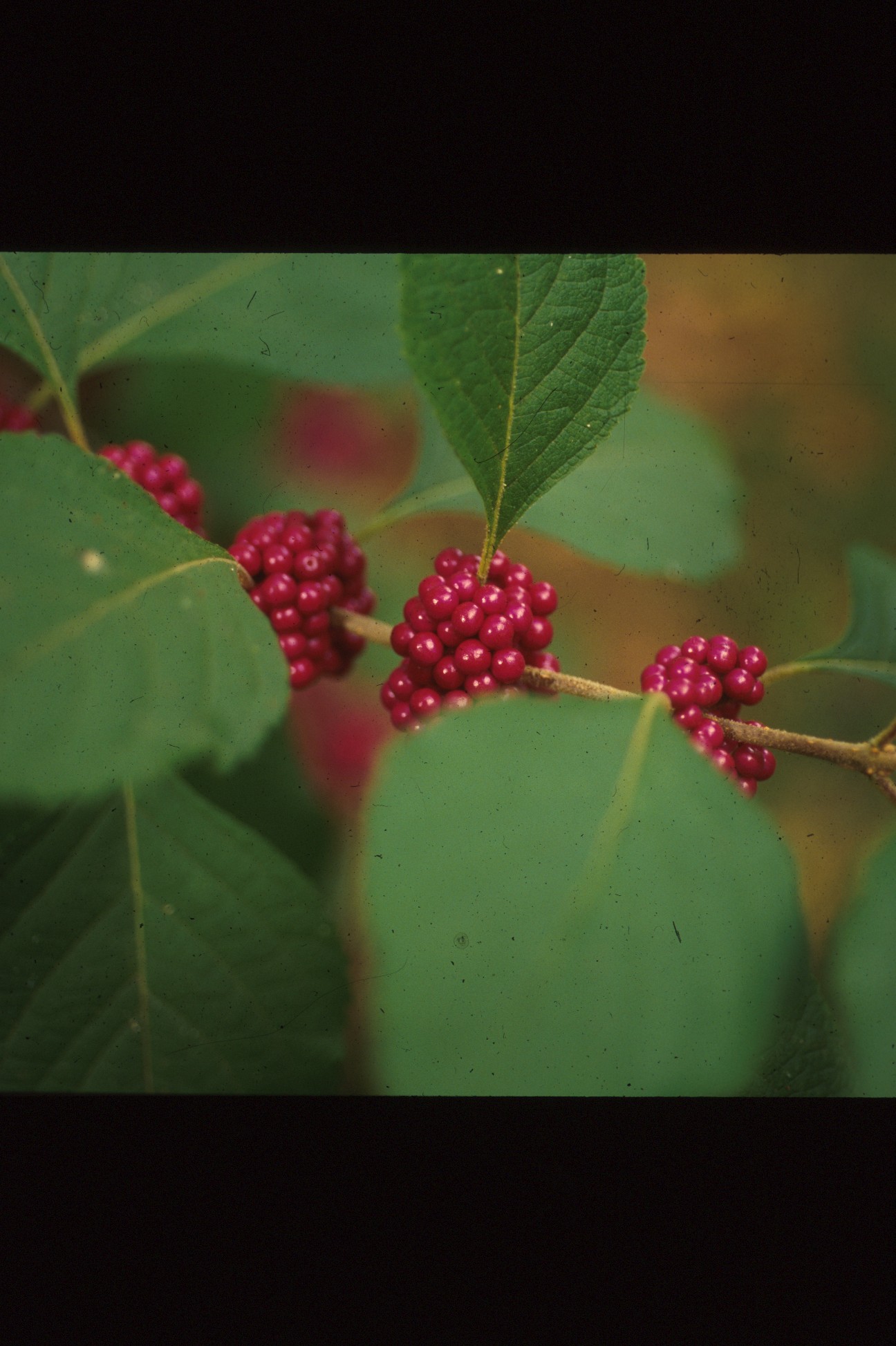
Beautyberry
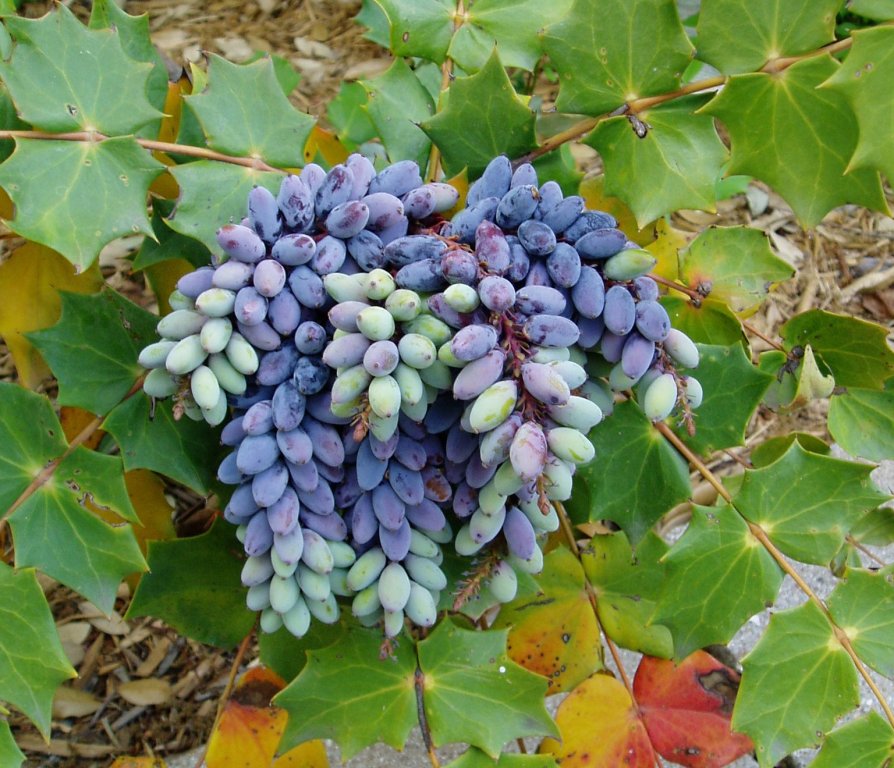
Leatherleaf Mahonia
Attract Wildlife
Many gardeners not only enjoy plants in the landscape, but also the wildlife that
may be attracted to it. The following shrubs may attract wildlife by the fruit they
produce or by providing physical protection.
- Abelia (Abelia spp.)
- Azalea (Rhododendron spp.)
- Barberry (Berberis spp.)
- Bayberry (Myrica pensylvanica)
- Beautyberry (Callicarpa spp.)
- Blackberry (Rubus spp.)
- Blueberry (Vaccinium spp.)
- Buckthorn, Carolina (Rhamnus carolinianus)
- Butterfly Bush (Buddleia spp.)
- Cherrylaurel, Carolina (Prunus caroliniana)
- Corralberry, Indiancurrant or Buckbrush (Symphoricarpos orbiculatus)
- Currant, Clove (Ribes odoratum)
- Dogwood, Roughleaf (Cornus drummondii)
- Eastern Wahoo (Euonymus atropurpureus)
- Elder, American or Elderberry (Sambucus canadensis)
- Firethorn (Pyracantha coccinea)
- Grapeholly (Mahonia spp.)
- Holly (Ilex spp.)
- Juniper (Juniperus spp.)
- Magnolia, Sweet Bay (Magnolia virginiana)
- New Jersey Tea (Ceanothus americanus)
- Plum, Sand (Prunus augustifolia)
- Privet (Ligustrum spp.)
- Quince, Flowering (Chaenomeles spp.)
- Rose (Rosa spp.)
- Spicebush (Lindera benzoin)
- Strawberry bush (Euonymus spp.)
- Sumac (Rhus spp.)
- Viburnum (Viburnum spp.)
- Weigela (Weigela spp.)
- Yucca (Yucca spp.)
Native Species
Native, in this context, is defined as any plant native to somewhere in the lower
48 contiguous states, not just Oklahoma.
- Bayberry, northern (Myrica pensylvanica)
- Beautyberry (Callicarpa americana)
- Bladdernut, American (Staphylea trifolia)
- Blueberry, highbush (Vaccinium corymbosum)
- Bush-Honeysuckle, Southern (Diervilla sessilifolia)
- Buttonbush (Cephalanthus occidentalis)
- Carolina Allspice or Sweetshrub (Calycanthus floridus)
- Chokeberries, Red and black (Aronia arbutifolia and A. melanocarpa, respectively)
- Currant, Clove (Ribes odoratum)
- Devil’s walkingstick (Aralia spinosa)
- Fothergilla, Dwarf (Fothergilla gardenii)
- Fothergilla, large (Fothergilla major)
- Grapeholly (Mahonia spp.)
- Holly, American (Ilex opaca)
- Holly, common winterberry (Ilex verticillata)
- Holly, Deciduous or possumhaw (Ilex decidua)
- Holly, inkberry (Ilex glabra)
- Hydrangea, smooth (Hydrangea arborescens)
- Hydrangea, Oakleaf (Hydrangea quercifolia)
- Juniper (Juniperus spp.)
- Ninebark, purple, Diablo™ (Physocarpus opulifolius ‘Monlo’)
- Palmetto (Sabal minor)
- Rhododendron and azalea (Rhododendron spp. & cultivars)
- Summersweet or sweet pepperbush (Clethra alnifolia)
- Sweetspire, Virginia (Itea virginica)
- Viburnum, American cranberrybush (Viburnum trilobum)
- Viburnum, arrowwood (Viburnum dentatum)
- Viburnum, blackhaw (Viburnum prunifolium)
- Viburnum, Southern blackhaw (Viburnum rufidulum)
- Yellowroot (Xanthorhiza simplissima)
Make Good Hedges
Many shrubs are suitable for use as a hedge. However, some work better than others depending on if they are trained into a clipped, formal hedge or pruned more informally to maintain the natural form and shape of the plant. Plants with smaller leaves, as opposed to wide, large leaves, work best for formal, clipped hedges.
Shrubs for formal, clipped hedge:
- Abelia (Abelia spp.)
- Barberry, Wintergreen (Berberis julianae)
- Boxwood (Buxus spp.)
- Devilwood, False holly or Osmanthus (Osmanthus heterophyllus)
- Holly (Ilex spp.)
- Yews (Taxus spp.)
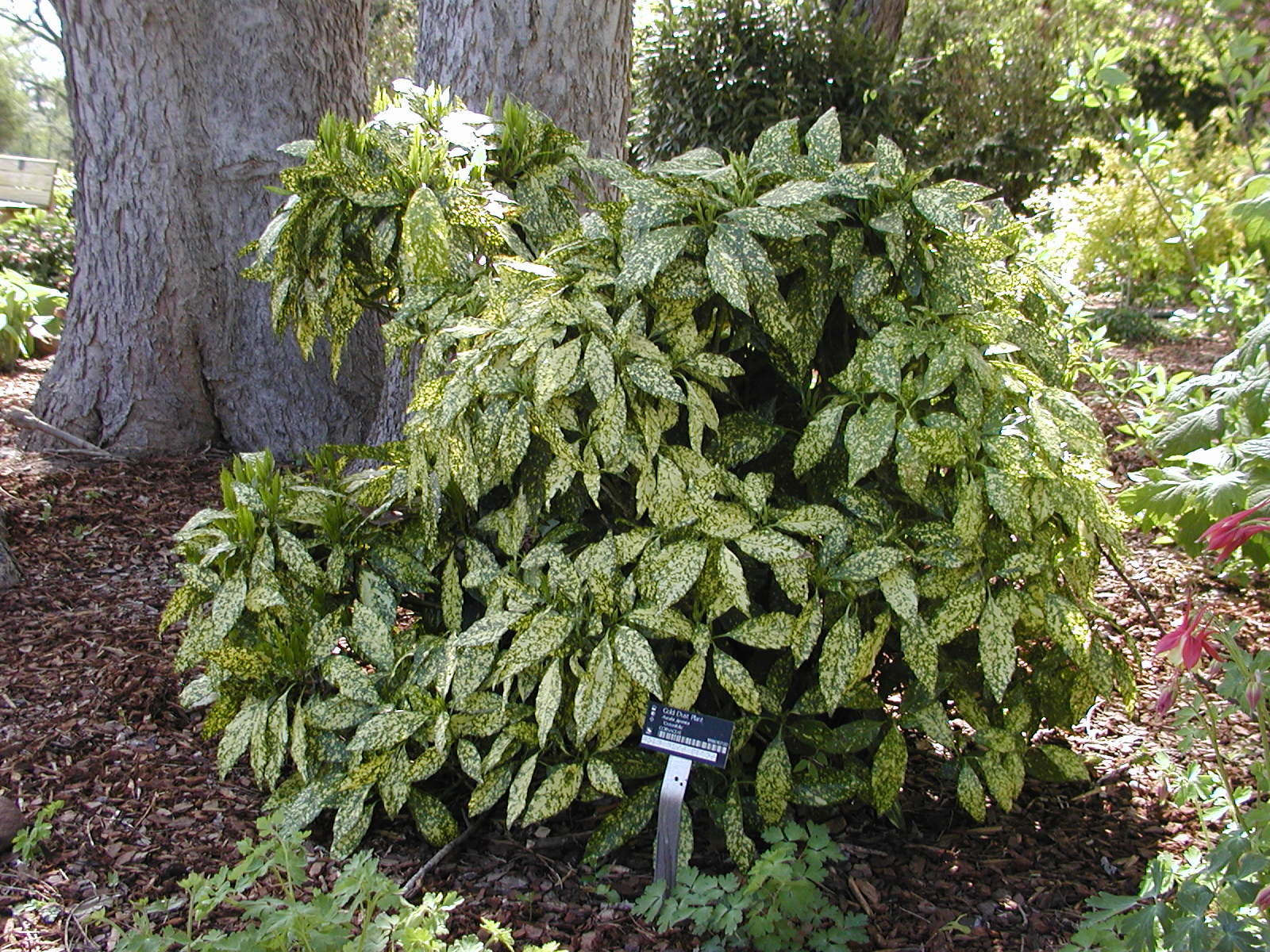
Aucuba – Gold Dust Plant
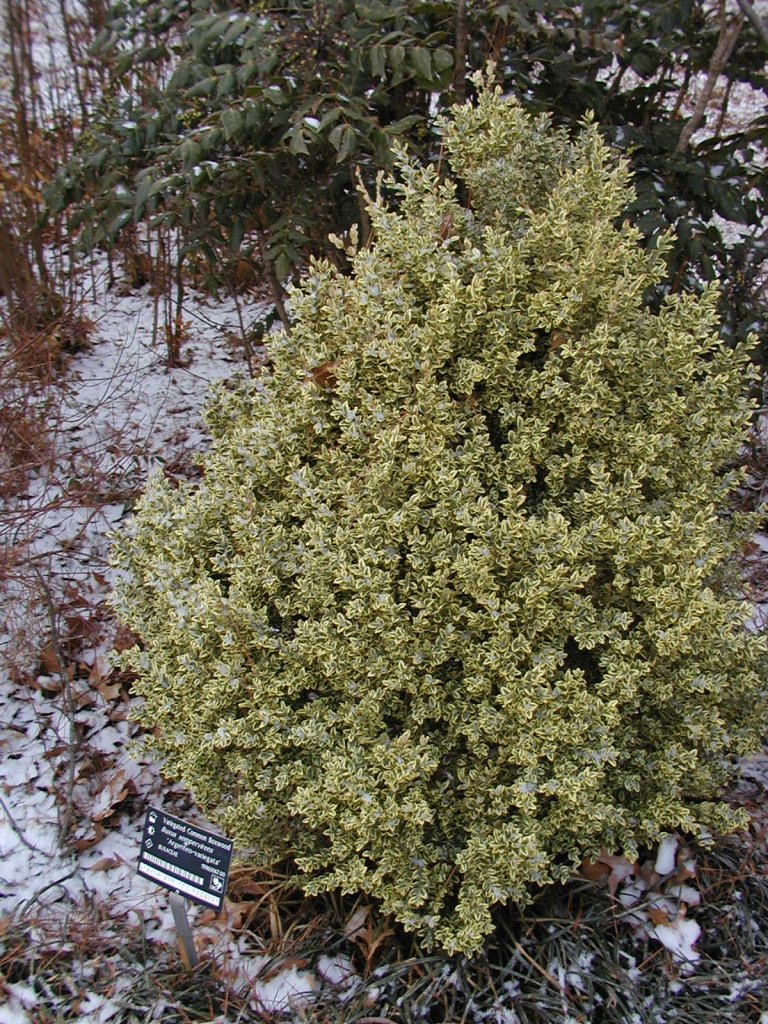
Green Mountain Boxwood

Pencil Yaupon Holly
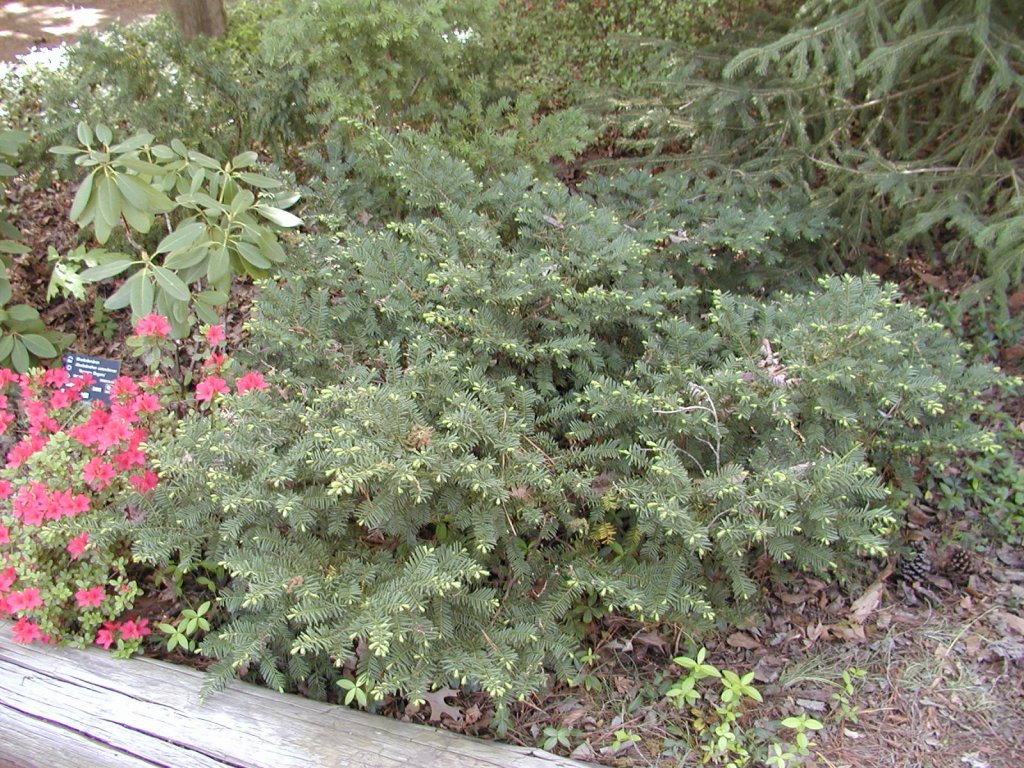
Yew
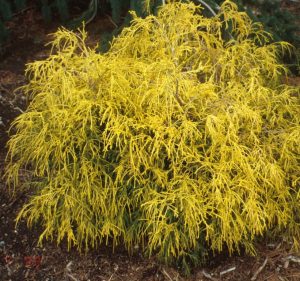
Chamaecyparis
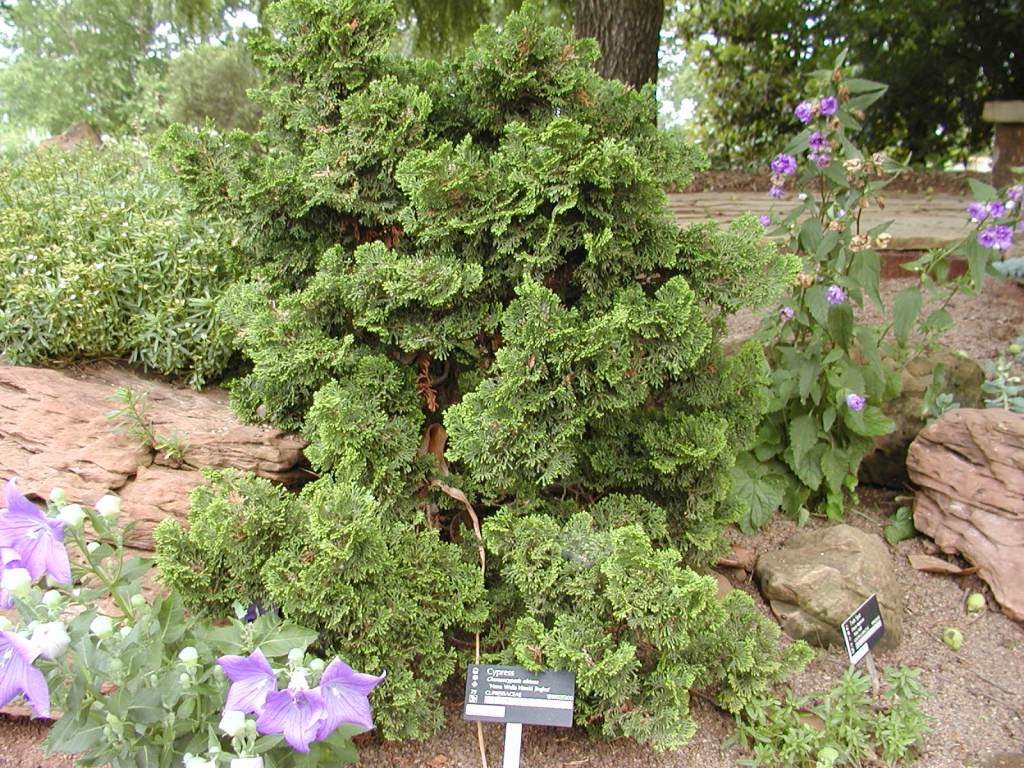
Falsecypress
Shrubs for natural hedges:
- Abelia (Abelia spp.)
- Barberry (Berberis spp.)
- Boxwood (Buxus spp.)
- Cherrylaurel (Prunus spp.)
- Cotoneaster (Cotoneaster spp.)
- Crapemyrtle (Lagerstroemia spp.)
- Firethorn (Pyracantha spp.)
- Forsythia (Forsythia cultivars)
- Holly (Ilex spp.)
- Honeysuckle (Lonicera spp.)
- Juniper (Juniperus spp.)
- Photinia (Photinia spp.)
- Privet (Ligustrum spp.)
- Rose (Rosa spp.)
- Viburnum (Viburnum spp.)
Evergreens for Background and Screens:
- Arborvitae (Thuja spp.)
- Azaleas (Rhododendron hybrids)
- Boxwood (Buxus spp.)
- Cherrylaurel (Prunus spp.)
- Devilwood, False holly or Osmanthus (Osmanthus heterophyllus)
- Holly (Ilex spp.)
- Juniper, Chinese (Juniperus chinensis cultivars)
- Privet (Ligustrum spp.)+
- Rhododendron (Rhododendron spp.)
- Viburnum (Viburnum spp.)
- Waxmyrtle (Morella cerifera)
- Yews (Taxus spp.)
Evergreen Shrubs
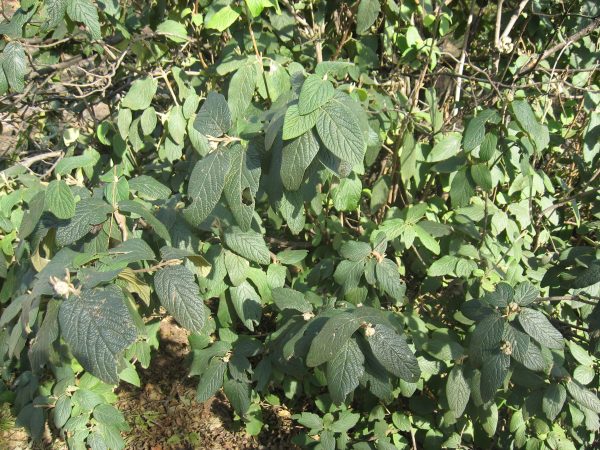
Viburnum
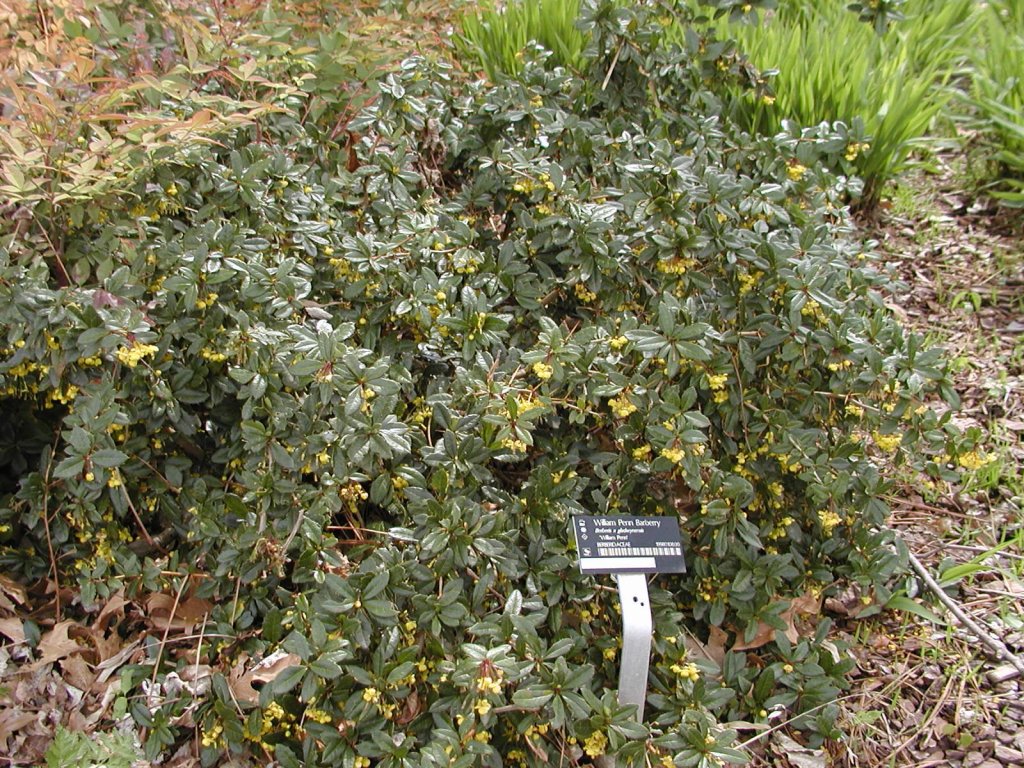
William Penn Barberry
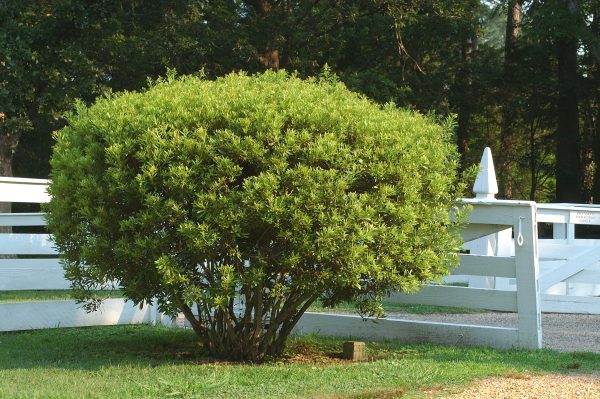
Southern Waxmyrtle
Make Good Ground Covers
Shrubs that tend to spread or creep along the ground, or don’t grow more than 30 inches
tall and when planted close together cover the ground, may be used as ground covers.
Plants with attractive foliage and dense growth habit make the best ground covers.
- Abelia, dwarf (Abelia x grandiflora ‘Prostrata,’ ‘Edward Goucher’ and others)
- Azaleas, low and spreading (Azalea hybrids)
- Barberry, Crimson Pygmy (Berberis thunbergii atropurpurea ‘Crimson Pygmy’)
- Cotoneaster, rockspray (Cotoneaster horizontalis)
- Cotoneaster, willowleaf (Cotoneaster salicifolius ‘Repens’)
- Holly, dwarf yaupon (Ilex vomitoria ‘Schelling’s Dwarf’ and other cultivars)
- Holly, Japanese (Ilex crenata ‘Stokes’ and other cultivars)
- Juniper, Chinese (Juniperus chinensis cultivars)
- Junipers, creeping (Juniperus horizontalis ‘Blue Rug’ and other cultivars)
- Juniper, shore (Juniperus conferta cultivars)
- Leucothoe, drooping (Leucothoe fontanesiana)
- Nandinas, Dwarf (Nandina domestica ‘Harbor Dwarf” and other cultivars)
- St. Johnswort, shrubby (Hypericum patulum)
- Summersweet, ‘Hummingbird’ (Clethra alnifolia ‘Hummingbird’)
- Yellowroot (Xanthorhiza simplissima)
- Yew, anglojap (Taxus x media)
Table 1. Deciduous Shrubs (some grow naturally as small trees or can be trained as a standard)*
| Common Name – Botanical Name | Species Characteristics | ||||
|---|---|---|---|---|---|
| Deciduous Shrubs | Height ft. | Spread ft. | Region | Comments | |
| Althea or Rose of Sharon (Hibiscus syriacus) | 8-12 | 6-10 | A | Wildscape candidate. Red, white, pink and purple flowers. | |
| Aralia, Fiveleaf (Eleutherococcus sieboldianus) | 8-10 | 8-10 | A | Tolerant of acid or alkaline, sand or clay; very drought tolerant. 'Variegatus' has bright green foliage with creamy white edges that stand out in shaded areas. | |
| Barberry, Japanese (Berberis thunbergii) | 3-6 | 4-7 | A | Green foliage, small thorns, red fruits. | |
| Barberry, Mentor (B. x mentorensis) | 5 | 5-7 | A | Yellow flowers, semi-evergreen. | |
| Barberry, Red leaf (B. thunbergii atropurpurea) | 3-6 | 4-7 | A | Reddish or purple foliage, many selections available. | |
| Bayberry (Myrica pensylvanica) | 5-12 | 5-12 | NE, SE | Male and female plants needed for good fruit development. | |
| Beautyberry, Purple (Callicarpa dichotoma) | 3-4 | 4-5 | A | White fruits available. | |
| Beautybush (Kolkwitzia amabilis) | 6-10 | 5-8 | A | Prune to expose exfoliating bark. | |
| Bladdernut, American (Staphylea trifolia) | 10-15 | 10-15 | NE, SE | Good plant for naturalizing; suckers. White flowers in spring; interesting bladderlike fruits. Prefers moist, well-drained soil. | |
| Bluebeard or Blue-mist Shrub (Caryopteris x clandonensis) | 3-5 | 3-5 | A | Sometimes freezes back, but regenerates from roots. True blue flowers. | |
| Blueberry, Highbush (Vaccinium corymbosum) | 4-12 | 5-12 | NE, SE | Popular for tasty fruit; many cultivars available. Good ornamental for spring flowers, colorful berries and nice fall color; also an excellent plant to attract wildlife. Needs acid soils. | |
| Buckthorn, Carolina or Indian Cherry (Rhamnus caroliniana) | 10-15 | 10-15 | A | Handsome foliage and beautiful fruit that turn red to black as they mature. Large shrub or small tree. Native species. | |
| Buddleia, Butterfly Bush (Buddleia davidii) | 5-10 | 4-5 | A | Wildscape plant. Attracts butterflies. | |
| Buffaloberry, Silver (Shepherdia argentea) | 6-10 | 6-10 | Good for poor, dry, high pH soils. Thorny. Red or orange fruits, yellow-fruited selections available. | ||
| Bush Cinquefoil (Potentilla fruticosa) | 1-4 | 2-4 | A | May suffer from heat stress. Flowers in a variety of colors. | |
| Bush-honeysuckle, Southern (Diervilla sessilifolia) | 3-5 | 3-5 | Glossy dark green leaves, yellow flowers in summer. Very adaptable and pest free. | ||
| Buttonbush (Cephalanthus occidentalis) | 3-6 | A | Good for growing in or near ponds, but also tolerant of normal landscaping conditions. Glossy foliage, white flowers, button-like fruit. | ||
| Carolina Allspice or Sweetshrub (Calycanthus floridus) (also California Sweetshrub, Calycanthus occidentalis) | 6-9 | 6-12 | A | Fragrant flowers. Prefers deep, moist loam. Adapts to acid and alkaline soils. Shade or sun. | |
| Chokeberry, Black (Aronia melanocarpa) | 3-5 | 3-5 | A | Suckers profusely forming large colonies over time. Provides year round interest. | |
| Chokeberry, Purple-fruited (A. x prunifolia) | 8 | 4-6 | A | Tends to sucker. Good for banks and difficult to mow areas. | |
| Chokeberry, Red (A. arbutifolia) | 6-10 | 3-5 | A | Tends to sucker. Good for banks and difficult to mow areas. | |
| Corralberry, Chenault (Symphoricarpos x chenaultii) | 2-6 | 3-12 | A | Low spreading arching. Cultivars available; colorful berries; wildlife plant. | |
| Corralberry, Indiancurrant or Buckbrush (S. orbiculatus) | 2-5 | 4-8 | A | Colorful fruit that persist into winter; good wildlife plant. Several cultivars available. | |
| Cotoneaster, Cranberry (Cotoneaster apiculatus) | 3 | 3-6 | A | Occasional disease and insect problems. Showy fruits. | |
| Cotoneaster, Rock (C. horizontalis) | 2-3 | 5-8 | A | Occasional disease and insect problems. Showy fruits. | |
| Cotoneaster, Spreading (C. divaricatus) | 5-6 | 6-8 | A | Occasional disease and insect problems. Showy fruits. | |
| Crapemyrtle (Lagerstroemia indica) | 6-20 | A | Many cultivars available. Actual size of plant is based on cultivar. Choose powdery mildew resistant varieties. In colder areas, may freeze back, but will regrow from roots. | ||
| Currant, Clove, Missouri, or Golden (Ribes odoratum) | 6-8 | 4-5 | A | Yellow, clove-scented flowers, edible fruit. | |
| Desert-willow (Chilopsis linearis) | 15-25 | 10-15 | NW, SW | Large shrub or small tree for dry, well-drained soils. Showy flowers early to mid summer. | |
| Devils-walkingstick (Aralia spinosa) | 10-20 | 10-20 | A | Has bi- to tri-pinnately compound leaves providing a tropical effect. Stems spiny. Somewhat of a novelty plant that is adapted to a wide range of growing conditions. | |
| Dogwood, Gray (Cornus racemosa) | 10-15 | 10-15 | NE, SE | Good for naturalizing; good winter characteristics. Fruit favored by birds. | |
| Dogwood, Redosier or Red Twig (C. sericea) | 7-9 | 10 | A | Hot, humid conditions may lead to decline. Red twigs showy in win. | |
| Dogwood, Roughleaf (C. asperifolia and C. a. var. drummondii) | 15 | 15 | NE, SE | Good for naturalizing in moist and wet soils. Spring flowers and late summer fruit good for wildlife. | |
| Dogwood, Silky (C. amomum) | 6-10 | 6-10 | NE, S | Good for naturalizing in moist and wet soils. Yellowish white spring flowers and bluish, late summer fruit good for wildlife. | |
| Eastern Wahoo (Euonymus atropurpureus) | 12-24 | 8-10 | A | Attractive fall color and fruits. Can be trained as a tree. | |
| Elder, American or Elderberry (Sambucus canadensis) | 5-12 | 5-12 | A | White summer flowers. Purple-black fruit; attracts birds. Suckers profusely. Cultivars available. | |
| Euonymus, American or Strawberry-bush (E. americanus) | 4-6 | 3-4 | A | Can be infected by scale. Red fall color and showy fruits. | |
| Euonymus, Winged or Burning Bush (E. alatus) | 10-20 | 10-20 | A | Does not contract scale. Dwarf cultivars available, five to 10 feet high and wide. | |
| Fig, Common (Ficus carica) | 8-10 | 5-7 | NE, SE | Fruit is edible. May freeze back from harsh winters. | |
| Forsythia (Forsythia x intermedia) | 8-10 | 10-12 | A | Very early yellow flowers. | |
| Fothergilla (Fothergilla spp.) | 6-10 | 5-8 | NE, SE | Prefers acid soils. Interesting white flowers appear before leaves in early spring. Provide shade for optimal growth; leaf scorch may occur if planted in full sun. | |
| Hardy Orange (Poncirus trifoliata) | 8-20 | 6-15 | NE, SE | Prefers well-drained, acid soils. Bright green stems with spines up to 2 inches. A yellow, very sour fruit is produced in fall. A novelty plant; can be used as a thick hedge. | |
| Harry Lauder's Walkingstick or Contorted Filbert (Corylus avellana 'Contorta') | 8-10 | 8-10 | A | Interesting stems that curl and twist. Leaves also twisted. | |
| Holly, Common Winterberry (Ilex verticillata) | 6-10 | 6-10 | NE, SE | Adaptable to wet conditions. Prefers moist, acid soils. Full sun or part shade. Colorful fruits. Many cultivars and hybrids available. | |
| Holly, Deciduous or Possumhaw (I. decidua) | 7-15 | 7-15 | A | Very durable plant. Best ornamental attribute is the showy, colorful fruits that persist into the winter months. Several cultivars are available including weeping forms and those offering fruit colors from yellow, orange to red. | |
| Honeysuckle, Morrow (Lonicera morrowii) | 6-8 | 6-10 | A | Red fruits, shrub type habit. | |
| Honeysuckle, Tatarian (L. tatarica) | 10-12 | 10 | A | Considered weedy. Many cultivars. | |
| Honeysuckle, Winter (L. fragrantissima) | 6-10 | 6-10 | A | Exceptional fragrance. Blooms in Feb.-March. Semi-evergreen. | |
| Hydrangea (Hydrangea spp.) | 3-6 | 3-6 | A | Showy flowers, pH sensitive. | |
| Hydrangea, Oakleaf (Hydrangea quercifolia) | 4-6 | 4-6 | A | Best in shade, moist soil. Showy flowers, good fall color, many cultivars available. Oklahoma Proven selection. | |
| Jasmine, Winter (Jasminum nudiflorum) | 3-4 | 4-7 | A | Flowers December - March. Bright yellow flowers. Young stems bright green. | |
| Jetbead, Black (Rhodotypos scandens) | 3-6 | 4-9 | A | Durable and adaptable to differing soil conditions; pH adaptable. Tolerant of shade or sun. White flower on tips of branches appear late spring or early summer followed by shiny black fruits. Good for heavy shade, shrub borders or masses. | |
| Kerria, Japanese (Kerria japonica) | 3-6 | 6-9 | A | Full shade; bright yellow flowers in late spring or early summer. Green stems are showy in winter. Oklahoma Proven Selection. | |
| Lilac, French or Common (Syringa vulgaris and other related species.) | 8-15 | 6-12 | A | Seek out local expertise when choosing lilacs. Besides finding mildew-resistant types, inquire about fragrance and other ornamental characteristics. | |
| Mockorange, Sweet (Philadelphus coronarius and related spp.) | 10-12 | 10-12 | A | Many types available for white, fragrant spring flowers. | |
| New Jersey Tea (Ceanothus americanus) | 3-4 | 3-5 | A | Prefers light, well-drained soils; tolerates dryness, avoid excessive irrigation. Low, compact shrub with white flowers mid summer. | |
| Ninebark, dwarf (Physocarpus opulifolius) | 5-7 | 5-6 | A | DiabloTM and other purple leaf selections are available. | |
| Paradise Poinciana or Bird of Paradise (Caesalpinia gilliesii) | 10 | 6-8 | NE, SE, SW | May freeze back depending upon variety and planting location, but often root hardy. Grow for tropical looking flowers. | |
| Parrotia, Persian (Parrotia persica) | 20-30 | 15-30 | A | Large shrub or small tree. Prefers well-drained, slightly acid soil. Is quite tolerant of heat, drought, wind and cold once established, but appreciates late shade. Interesting deep maroon flowers appear in late winter. New growth reddish in color changing to a lustrous green for summer; can be a brilliant yellow or orange in fall. Bark exfoliates leaving patches of green, cream, and gray adding year round interest. | |
| Pearl Bush, common (Exochorda racemosa; E. x macrantha) | 10-15 | 10-15 | NE, SE | White flowers. | |
| Plum, American or Wild (Prunus americana) | 15-20 | 15-20 | A | Native species that grows into a shrub or small tree. Often forms large colonies from suckering. Early white spring flowers. Fruit yellow to red, with thick skin and juicy sour edible pulp. Eaten fresh and in jellies and preserves. Good for erosion control and attracting wildlife. | |
| Plum, Sand or Chickasaw (P. angustifolia) | 6 | 6 | A | Sand plum develops mostly into a thicket-forming shrub though it can become a small tree. Spreads by suckers. Early white spring flowers. Fruit shiny red though sometimes yellow; edible. Grows in sandy soils. Thickets serve as erosion control and provide food and cover for wildlife. | |
| Pomegranate (Punica granatum) | 12-20 | 12-20 | NE, SE | Glossy foliage; orange flowers; edible fruit; may freeze back. | |
| Privet, Amur (Ligustrum amurense) | 12-15 | 8-10 | A | Very adaptable shrub to most growing conditions except very wet soils. Takes well to pruning and is often used as a hedge. | |
| Privet, Common or Hedge plant (Ligustrum vulgare) | 12-15 | 12-15 | A | Good for “instant” hedge. | |
| Privet, Golden or Golden Vicary (L.x vicaryi) | 10-12 | 6-8 | A | Golden yellow foliage color. | |
| Quince, Flowering (Chaenomeles speciosa) | 6-10 | 6-10 | A | White, pink, or red flowers. | |
| Rose (Rosa spp.) | 4-6 | 4-6 | A | Seek grower advice for disease resistant cultivars. | |
| Saint John’s-wort (Hypericum patulum) | 3-4 | 3-4 | A | Yellow summer flowers. | |
| Serviceberry (Amelanchier species) | 6-25 | 6-25 | NE, SE | Prefer moist, acid soils. Year round interest, white to pink spring flowers; edible fruits that may turn red to black to purplish-black; good fall color. Several cultivars | |
| Siberian Peashrub (Caragana arborescens) | 15-20 | 12-18 | A | Grows well in tough sites; yellow flowers. | |
| Smoketree or Smokebush (Cotinus coggygrria) | 10-15 | 10-15 | A | Unique flowers panicles appear in summer. Tiny hairs on panicles clusters turn a smoky pink to purplish giving the appearance of puffs of smoke coming from the shrub. Purple leaf forms available; fall color can be spectacular on cultivars. Adaptable to wide range of soil and pH conditions. | |
| Snowberry (Symphoricarpos albus) | 3-6 | 3-6 | A | White fruits. S. orbiculatus has pink fruits. | |
| Spicebush (Lindera benzoin) | 6-12 | 6-12 | NE, SE | Does best in well-drained moist soils; sun to part shade. Yellow to golden yellow fall color. Bright scarlet fruits are attractive on female plants after leaves have fallen. | |
| Spirea, Anthony Waterer (Spiraea x bumalda ‘Anthony Waterer’) | 3-4 | 4-5 | A | Pink summer flowers. | |
| Spirea, Magic Carpet (S. japonica ‘Magic Carpet’) | 2-3 | 2-3 | A | Orange-red to reddish purple young new shoots, yellow-gold at maturity, pinkish flowers. | |
| Spirea, Vanhoutte (S. x vanhouttei) | 6-8 | 10-12 | A | Common shrub with arching, fountain-like habit with spectacular spring display of white flowers. Very tough. | |
| Sumac, Cutleaf (Rhus glabra ‘Laciniata’) | 10-15 | 10-15 | A | Leaflets deeply cut and lobed; produces bright scarlet fruit. | |
| Sumac, fragrant (R. aromatica) | 2-6 | 6-10 | Low spreading shrub. Glossy green summer foliage, turning orange to red to purplish-red in fall. Very drought tolerant. 'Gro-low' has yellow female flowers that produce hairy red fruits; good groundcover, foundation plant, attracts wildlife, and can be used to control erosion on slopes. | ||
| Sumac, Smooth (R. glabra) | 10-15 | 10-15 | A | Excellent fall color; crimson fruits on female plants. Suckers form colonies. Tough plant found growing in difficult sites. | |
| Sumac, Staghorn (R. typhina) | 15-25 | 15-25 | A | Excellent fall color; crimson fruits on female plants. Suckers form colonies. Tough plant found growing in difficult sites. | |
| Summersweet or Sweet Pepperbush (Clethra alnifolia) | 4-8 | 4-6 | NE, SE | Easy to grow native shrub. Prefers acid soils; grows in wet places, sun or partial shade. Excellent summer flowers are fragrant and attract bees and butterflies. Many cultivars available. Good yellow fall color. | |
| Sweetspire, Virginia (Itea virginica) | 3-5 | 3-5 | NE, SE | White flower, showy fall color. | |
| Viburnum, American Cranberrybush (Viburnum trilobum) | 3-12 | 4-12 | A | Native species that prefers moist, well-drained soils; will decline under moisture stress. White spring flowers and bright red fruits that are edible and sometimes used in preserves. Leaves medium to dark green in summer, turning yellow to red-purple in fall; new growth has reddish tinge. Excellent foliage, flower and fruiting characteristics; makes good screen and informal hedge; neat compact forms available. | |
| Viburnum, Arrowwood (Viburnum dentatum) | 6-8 | 6-15 | A | Showy blue fruits. Several cultivars available. | |
| Viburnum, Blackhaw (V. prunifolium) | 12-15 | 8-12 | A | Native species adaptable to many soils, does well in dry soils; sun or shade. Creamy white spring flowers; fruits pinkish, rose, maturing to bluish black, edible. Good summer leaf color changing to red to purplish red in fall. | |
| Viburnum, Burkwood (V. x burkwoodii) | 8-10 | 6-8 | A | Fragrant flowers. | |
| Viburnum, Doublefile or Japanese (V. plicatum var. tomentosum) | 8-10 | 9-12 | NE, SE | White flowers, heavily floriferous. | |
| Viburnum, European or Snowball (V. opulus) | 8-12 | 10-15 | A | White flowers, red fruits. | |
| Viburnum, Siebold (V. sieboldii) | 15-20 | 10-15 | A | Creamy white spring flowers. Red fruits, attract birds. Dark shiny green summer foliage. Prefers moist, well-drained soils, pH adaptable. Grows in sun or part shade; may scorch in dry soils. | |
| Viburnum, Southern Blackhaw or Rusty Blackhaw (V. rufidulum) | 10-20 | 8-20 | A | Native species with creamy white spring flowers and dark blue fruit. Leaves turn burgundy in fall. Very drought tolerant. | |
| Vitex, or Chaste Tree (Vitex agnus-castus) | 8-10 | 9-10 | A | Lavender, pink, or white flowers, attractive foliage. Attracts butterflies. May freeze, but will regenerate from roots. | |
| Weigela (Weigela florida) | 6-9 | 9-12 | A | Many cultivars. | |
| Willow, Goat or Pussy (Salix caprea) | 15-25 | 12-15 | A | Fast growth, showy winter or early spring flowers. | |
| Woadwaxen (Genista species) | 2-3 | 2-3 | A | Good low growing plant for poor, dry soils. Beautiful yellow early summer flowers. Bright green summer foliage. | |
| Winterhazel (Corylopsis spp.) | 4-20 | 4-15 | NE, SE | Prefers moist, acid, well-drained soil. Shelter from late freezes to protect early, pale yellow, fragrant flowers that appear before leaves in spring. | |
| Witchhazel (Hamamelis vernalis) | 6-10 | 4-5 | SW, NE, SE | Grow for winter flowers. | |
| Yellowroot (Xanthorhiza simplicissima) | 2-3 | NE, SE | Native species excellent as a ground cover. Bright green summer foliage, may develop yellow or golden orange fall color. Spreads freely in moist areas, less aggressive in dry soils; will do well in heavy soils; avoid high pH soils. Full sun or partial shade. A yellow dye can be made from the sap. |
* Many varieties and cultivars of shrubs exist that are not listed. For the sake of brevity, only one or two samples are provided for any given group of plants. For example, there are numerous variations or cultivars of barberry, viburnum and others selected for foliage or flower color, size, etc.
Table 2. Evergreen Shrubs
| Common Name – Botanical Name | Species Characteristics | ||||
|---|---|---|---|---|---|
| Coniferous Shrubs (Narrowleaf) | Height ft. | Spread ft. | Region | Comments | |
| Arborvitae (Thuja species) | 1 - 30 | 1 - 15 | A | Large shrubs to small trees; many cultivars available within each species, dwarf to compact forms available. Use for foundation plantings, screens, windbreaks, accent plants, or hedges. Prefer fertile, moist, well-drained soils though most are quite tough once established. Best in full sun. | |
| Falsecypress (Chamaecyparis species) | 3+ | 3+ | NE, SE | Loam soil. Part sun. Shelter from hot wind and afternoon sun. Many are large plants,even trees. Select cultivars that best fit location, such as dwarf forms. Used more as a specimen plant in protected areas of Oklahoma landscapes. | |
| Juniper, Chinese (Juniperus chinensis) | 1-25+ | 3 - 10 | A | Size varies significantly depending on cultivar and there are many. Spreading shrub to upright shrub or tree. | |
| Juniper, Creeping (J. horizontalis) | 1 - 2 | 4 - 8 | A | Size is variable, but definitely low-growing, spreading type. | |
| Juniper, Japgarden (J. procumbens) | 3 - 4 | 10 - 15 | A | Attractive in planters. | |
| Juniper, Rocky Mountain (J. scopulorum) | 30-40 | 3 - 15 | NW, SW | Similar to native eastern red cedar. | |
| Juniper, Savin (J. sabina) | 4 - 6 | 5 - 10 | A | Several cultivars available. | |
| Juniper, Shore (J. conferta) | 1 - 2 | 6 - 9 | A | May have some shade tolerance. | |
| Pine, Mugo (Pinus mugo) | 15-20 | 25-30 | A | Low growing forms available from three to six feet tall. | |
| Spruce, Dwarf Alberta (Picea glauca 'Conica') | 10 - 12 | 6 - 8 | A | Very slow growing; cone-shaped and dense. Is not highly recommended, but is very common in the trade. Heat, humidity and wind can lead to stress; spider mites are a common problem. | |
| Yew, Anglojap (Taxus x media) | 2 - 20 | A | Cultivar Runyan has performed well in Oklahoma. | ||
| Yew, Japanese (T. cuspidata) | 5 - 15 | 5 - 15 | A | Size varies with cultivar. The cultivar Thayerae has performed well in Oklahoma. | |
| Broadleaf Evergreen Shrubs | Height ft. | Spread ft. | Region | Comments | |
| Abelia, Glossy (Abelia x grandiflora) | 3 - 6 | 3 - 6 | NE, SE, SW | May develop severe chlorosis in high pH soils. | |
| Aucuba (Aucuba japonica) | 6 - 10 | 5 - 8 | SE (NE) | Excellent for shady areas. Not drought tolerant. Tolerates moist clay soils. Variegated forms available. | |
| Azalea, (Rhododendron spp.) | Varies | Varies | NE, SE | Keep mulched, shelter from sun and wind. Not drought tolerant. High maintenance plant. Flowers and twigs poisonous if eaten. Vast selections available; confer with garden center personnel. | |
| Barberry, William Penn (Berberis x gladwynensis ‘William Penn’) | 4 | 4 | A | Showy foliage. Semi-evergreen. | |
| Barberry, Wintergreen or Juliane (B. julianae) | 6 - 8 | 6 - 8 | A | Very spiny, makes good barrier or hedge. Lustrous dark green leaves, yellow spring flowers, and bluish black fruits that persist into winter. | |
| Boxwood, Common or English (Buxus sempervirens) | 15-20 | 15-20 | A | Do not cultivate or over fertilize. Winter sunscald if not shaded. Many cultivars available, most grow smaller than species. | |
| Boxwood, Little Leaf (B. microphylla) | 3 - 4 | 3 - 4 | A | Slow growth, showy foliage, good for formal plantings. | |
| Camellia, Sasanqua (Camellia sasanqua) | NE, SE | Showy fall flowers. Some camellias yield winter flowers. Dark glossy green leaves. | |||
| Cherrylaurel or English Laurel (Prunus laurocerasus) | 10 - 18 | SW, NE, SE | Needs well-drained soil. Fragrant flowers. Toxic foliage. | ||
| Cherrylaurel, Carolina (Prunus caroliniana) | 20-30 | 15-25 | NE, SE | Evergreen, toxic foliage. | |
| Cotoneaster, Bearberry (Cotoneaster dammeri) | 1-1 ½ | 6+ | A | Semi-evergreen, attractive fruits. | |
| Cotoneaster, Willowleaf (C. salicifolius) | 1 - 15 | 8 - 12 | A | Low spreading cultivars are available. Lustrous dark green foliage, turns red to purple in winter. Colorful red fruits. | |
| Elaeagnus, Silverberry (Elaeagnus pungens) | 10 - 15 | 10 - 15 | A | Fruits seldom seen, but may attract birds. Semi-evergreen foliage used in hedges. | |
| Euonymus, Japanese (Euonymus japonicus several cultivars) | 5 - 10 | 5 - 10 | A | Glossy green leaf. Numerous cultivars available. Highly susceptible to scale insect. | |
| Euonymus, Spreading (E. kiautschovicus) | 8 - 10 | 8 - 10 | A | Fruit not showy, but interestingly attractive. ‘Manhattan’ cultivar is a superior species. | |
| Euonymus, Winter Creeper (E. fortunei) | 1 - 3 | 3-6+ | A | Many cultivars available. Leafspot and scale possible. | |
| Holly, American (Ilex opaca) | 15-30 | 12 - 20 | NE, SE | Well-drained, acid soils; sun to part shade. Leaves have spines. Medium drought tolerance, mulch. Most are large, tree like; much variation by cultivars in form and fruiting. Must have male and female plants for fruit. | |
| Holly, Chinese or Horned (I. cornuta) | 8 - 10 | 10+ | NE, SE | Spiny glossy leaf. Shelter from wind. Many cultivars available. Showy fruit on female plants, male is usually required for fruiting. | |
| Holly, The Blue or Meserve Hollies (I. x meserveae) | 8 - 20 | 5 - 10 | A | Should grow in northwest Oklahoma with shelter. Deep green leaves with blue gloss. Showy fruit on female plants. | |
| Holly, Fosters Hybrid (I. x attenuata) | 20-30 | NE, SE | Showy fruit on female plants. | ||
| Holly, Inkberry (semi-evergreen) (I. glabra) | 6 - 8 | 8 - 10 | NE, SE | Many cultivars available. Showy fruit on female plants. Prefers acid, moist soil. Will grow in swampy areas. | |
| Holly, Japanese (I. crenata) | 5 - 10 | 5 - 10 | NE, SE | Leaves without spines, dark green. Shelter from sun and wind. Best adapted to northeast Oklahoma. Many cultivars available. | |
| Holly, Yaupon (I. vomitoria) | 4 - 20 | 6 - 8 | A | Tough holly, but likes mulch and light amounts of fertilizer. Leaf without spines, dark green on top with gray back stems. Dwarf yaupon makes good substitute for boxwood. Can be sheared. More tolerant of wind and sun than other hollies. | |
| Honeysuckle, Winter (Lonicera fragrantissima) | 6 - 10 | 6 - 10 | A | Very fragrant flowers that bloom in late winter. Semi-evergreen. | |
| Indian Hawthorn (Rhaphiolepis spp.) | 4 - 6 | 4 - 6 | SE, SW | Marginally hardy. Flowers vary from late winter to early summer. Medium drought tolerance. Best for southern portions of Oklahoma. | |
| Laurel, Mountain (Kalmia latifolia) | 4 - 8 | 4 - 5 | NE, SE | Challenging to grow in Oklahoma; attractive flowers. | |
| Leucothoe, drooping (Leucothoe fontanesiana) | 3 - 6 | 3 - 6 | NE, SE | Graceful with spreading, arching branches. White fragrant flowers; bright green, bronze to purple leaves maturing to dark green, turning bronze to purple in fall. Must have moist, well-drained, acid soils; does not tolerate drought, drying winds prune to ground after flowering to rejuvenate. Fungal leaf spots can be a problem. | |
| Magnolia, Sweetbay (Magnolia virginiana) | 10 - 20 | 10 - 20 | NE, SE | Evergreen to semi-evergreen multi-stemmed shrub. Tolerates wet, swampy soils and shade. White creamy flowers in late spring are lemon-scented. Dark-red fruit with bright red seeds can be attractive. Native to eastern Oklahoma. | |
| Mahonia, Creeping (Mahonia repens) | 3/4-1 ¾ | 3 - 4 | A | Spreading, evergreen groundcover. Yellow spring flowers, grape-like fruit. | |
| Mahonia or Oregon Grapeholly (M. aquifolium) | 3 - 6 | 3 - 5 | A | Glossy, spiny, dark green leaf, new leaves red purple. Summer grape-like fruit. Best in part shade. Suckers and will form colonies. | |
| Mahonia, Leatherleaf (M. bealei) | 6 - 10 | 6 - 8 | NE, SE | Large, leathery, stiff, blue green leaf. Flowers are very fragrant. Grape-like fruit. Medium drought tolerance. | |
| Nandina or Heavenly Bamboo (Nandina domestica) | 4 - 8 | 4 - 5 | A | Lacy leaf. Small red fruit in fall. Tough plant, drought tolerant. Red fall leaf color. Many cultivars available; vary greatly in size. Semi-evergreen. | |
| Osmanthus, Devilwood or False Holly (Osmanthus heterophyllus) | 8 - 10 | 6 - 8 | SE | Flowers form in fall, are often hidden, but very fragrant. Shelter, keep mulched, watered and fertilized. Holly look-alike. | |
| Palmetto (Sabal minor) | May 8 | 5 | SE, NE | Native to southeast Oklahoma. Provides tropical flare to landscape. | |
| Photinia, Chinese (Photinia serrulata) | 20-25 | 14-16 | A | Resistant to leaf spot. | |
| Photinia, Redtip (P. x fraseri) | 10 - 15 | 5 - 8 | A | Pretty red new growth, may contract Entomosporium leaf spot. Prune in spring for density. Avoid wet or hot sites. Nitrogen fertilizer beneficial. Drought tolerant. | |
| Pieris, Japanese (Pieris japonica) | 3-4+ | 6 - 8 | NE, SE | Showy white flowers in spring. Moist, acid, well-drained soil. | |
| Pittosporum, Japanese (Pittosporum tobira) | 10 - 12 | 15-24 | SE | Should probably be limited to extreme southeast corner of Oklahoma. Smaller cultivars available. Fragrant creamy white flowers in spring. Relatively tough plant, not too finicky of site. Sun or heavy shade. Freeze injury possible. | |
| Privet, Japanese (Ligustrum japonicum) | 6 - 12 | 6 - 8 | NE, SE | Adaptable, withstands heavy pruning. White spring flower, dull black fruits. | |
| Pyracantha, Scarlet Firethorn (Pyracantha coccinea) | 6 - 18 | 6 - 18 | A | Outstanding, bright orange-red fruit persisting into winter. Some disease and insect problems. Does well in dry soil. Semi-evergreen. | |
| Rhododendron (Rhododendron hybrids) | Varies | Varies | NE, SE | Beautiful spring flowers. | |
| Viburnum, Alleghany (Viburnum x rhytidophylloides ‘Alleghany’) | 10 | 11 | NE, SE, NW, SW | These and many other viburnums are valued for spring flowers, often fragrant, pest-free deciduous or evergreen foliage, brilliant fall color, and showy fruits. | |
| Viburnum, Leatherleaf (Viburnum rhytidophyllum) | 10 - 15 | 10 - 15 | NE, SE | Showy fruits. Shelter from sun, reflected heat and wind. Not drought tolerant. | |
| Waxmyrtle, Southern (Morella cerifera) | 10 - 15 | 10 - 15 | NE, SE, SW, NW | Small clusters of gray fruit. Beautiful, wispy, shrub to small tree. Makes excellent pruned screen or limbed up to expose handsome gray, almost white bark. Spring growth develops rich bayberry candle odor. May defoliate in temperatures below zero degrees. | |
| Yucca, Adam’s Needle (Yucca filamentosa) | 3 - 4 | 3 - 4 | A | Cold hardy. Grows about anywhere except very wet sites. Produces yellowish-white pendulous flowers on three- to six-foot-tall stalk in summer. | |
| Yucca, Red (Hesperaloe parvifolia) | 3 - 4 | 3 - 4 | A | Dark pink to red flowers arising on a four- to five-foot stalk. |
* Many varieties and cultivars of shrubs exist that are not listed. However, for the sake of brevity, only one or two samples are provided for any given group of plants. For example, there are numerous variations or cultivars of barberry selected for foliage color, size, etc.
David Hillock
Assistant Extension Specialist, Consumer Horticulture
Kimberly Holmes
Former Assistant Extension Specialist
Mike Schnelle
Extension Ornamental Floriculture Specialist
